
Score Higher with Introduction To Trigonometry Class 10 Questions and Answers Practice
NCERT Solutions for Class 10 Maths Chapter 8 - Introduction to Trigonometry. Trigonometry, a fundamental branch of mathematics, explores the relationships between angles and sides of triangles. In this chapter, students delve into the basic concepts of trigonometry, such as trigonometric ratios, complementary angles, trigonometric identities, and their applications in solving problems related to heights and distances. These solutions are meticulously crafted by Vedantu’s subject expert with a clear understanding of the concepts, aiding students in mastering the fundamentals of trigonometry and preparing them for more advanced topics in mathematics.
 Table of Content
Table of ContentGlance of NCERT Solutions for Class 10 Maths Chapter 8 Introduction to Trigonometry | Vedantu
Trigonometry comes from Greek words meaning "three sides" and "measure."
The article covers the basics of Trigonometry and Trigonometric Ratios.
This chapter focuses on trigonometric ratios for acute angles (less than 90 degrees).
You will learn how to calculate these ratios for specific angles.
A table for the values of angles (0 Degree, 30 Degree, 45 Degree, 60 Degree, 90 Degree) with their corresponding trigonometric functions(sin, cos, tan, cot, sec, cosec) is provided.
There are relationships between these ratios, which you will explore (trigonometric identities).
Also, This article contains chapter notes, formulas, exercises links, and important questions for chapter 8 -Introduction to Trigonometry.
There are four exercises (27 fully solved questions) in class 10th maths chapter 8 Introduction to Trigonometry.
Access Exercise Wise NCERT Solutions for Chapter 8 Maths Class 10
S. No | Current Syllabus Exercises of Class 10 Maths Chapter 8 |
1 | NCERT Solutions of Class 10 Maths Introduction to Trigonometry Exercise 8.1 |
2 | NCERT Solutions of Class 10 Maths Introduction to Trigonometry Exercise 8.2 |
3 | NCERT Solutions of Class 10 Maths Introduction to Trigonometry Exercise 8.3 |
NCERT Solutions for Class 10 Maths Chapter 8 Introduction To Trigonometry



Score Higher with Introduction To Trigonometry Class 10 Questions and Answers Practice
Exercise 8.1 - In this exercise, students are introduced to the basic trigonometric ratios - sine, cosine, and tangent, and their reciprocal functions. They learn how to find the values of these ratios for acute angles in a right triangle. The exercise also covers the concept of trigonometric identities, which are fundamental relationships between trigonometric functions.
Exercise 8.2 - This exercise deals with the application of trigonometric ratios to solve real-life problems. Students learn how to use trigonometric ratios to find the height and distance of an object, as well as the angle of elevation and depression. They also learn how to use the Pythagorean theorem to solve problems involving right triangles.
Exercise 8.3 - The final exercise covers the concept of trigonometric equations. Students learn how to solve trigonometric equations using the identities and ratios learned in the previous exercises. They also learn how to find the general solution of a trigonometric equation, which involves finding all the possible solutions. Finally, the exercise covers the concept of the period of a trigonometric function and how to find it for different functions.
Access NCERT Solutions for Class 10 Maths Chapter 8 – Introduction to Trigonometry
Exercise 8.1
1. In $\Delta ABC$ right angled at $B$, $AB=24\text{ cm}$, $BC=7\text{ cm}$. Determine
(i) $\sin A,\cos A$
Ans: Given that in the right angle triangle $\Delta ABC$, $AB=24\text{ cm}$, $BC=7\text{ cm}$.
Let us draw a right triangle $\Delta ABC$, also $AB=24\text{ cm}$, $BC=7\text{ cm}$. We get
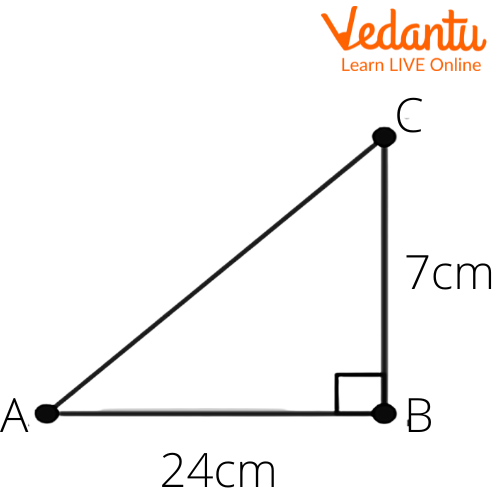
We have to find $\sin A,\cos A$.
We know that for right triangle
$\sin \theta =\dfrac{\text{opposite side}}{\text{hypotenuse}}$ and
$\cos \theta =\dfrac{\text{adjacent side}}{\text{hypotenuse}}$
Now, we need to apply the Pythagoras theorem to find the measure of hypotenuse.
In $\Delta ABC$, by Pythagoras theorem ,
${{\left( \text{hypotenuse} \right)}^{2}}={{\left( base \right)}^{2}}+{{\left( perpendicular \right)}^{2}}$
Here, $AB=24\text{ cm}$, $BC=7\text{ cm}$
We get
$\Rightarrow {{\left( \text{AC} \right)}^{2}}={{\left( AB \right)}^{2}}+{{\left( BC \right)}^{2}}$
$\Rightarrow {{\left( \text{AC} \right)}^{2}}={{\left( 24 \right)}^{2}}+{{\left( 7 \right)}^{2}}$
$\Rightarrow {{\left( \text{AC} \right)}^{2}}=576+49$
$\Rightarrow {{\left( \text{AC} \right)}^{2}}=625\text{ }c{{m}^{2}}$
$\Rightarrow AC=25\text{ cm}$
Now,
$\sin \theta =\dfrac{\text{opposite side}}{\text{hypotenuse}}$
$\Rightarrow \sin A=\dfrac{BC}{AC}$
$\therefore \sin A=\dfrac{7}{25}$
$\cos \theta =\dfrac{\text{adjacent side}}{\text{hypotenuse}}$
$\Rightarrow \cos A=\dfrac{AB}{AC}$
$\therefore \cos A=\dfrac{24}{25}$
(ii) $\sin C,\cos C$
Ans: Given that in the right angle triangle $\Delta ABC$, $AB=24\text{ cm}$, $BC=7\text{ cm}$.
Let us draw a right triangle $\Delta ABC$, also $AB=24\text{ cm}$, $BC=7\text{ cm}$. We get
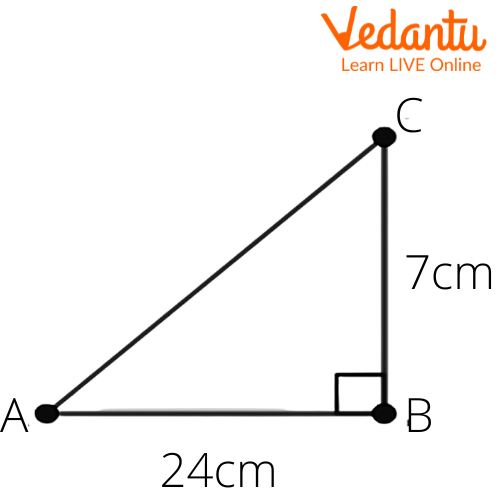
We have to find $\sin C,\cos C$.
We know that for right triangle
$\sin \theta =\dfrac{\text{opposite side}}{\text{hypotenuse}}$ and
$\cos \theta =\dfrac{\text{adjacent side}}{\text{hypotenuse}}$
Now, we need to apply the Pythagoras theorem to find the measure of hypotenuse.
In $\Delta ABC$, by Pythagoras theorem ,
${{\left( \text{hypotenuse} \right)}^{2}}={{\left( base \right)}^{2}}+{{\left( perpendicular \right)}^{2}}$
Here, $AB=24\text{ cm}$, $BC=7\text{ cm}$
We get
$\Rightarrow {{\left( \text{AC} \right)}^{2}}={{\left( AB \right)}^{2}}+{{\left( BC \right)}^{2}}$
$\Rightarrow {{\left( \text{AC} \right)}^{2}}={{\left( 24 \right)}^{2}}+{{\left( 7 \right)}^{2}}$
$\Rightarrow {{\left( \text{AC} \right)}^{2}}=576+49$
$\Rightarrow {{\left( \text{AC} \right)}^{2}}=625\text{ }c{{m}^{2}}$
$\Rightarrow AC=25\text{ cm}$
Now,
$\sin \theta =\dfrac{\text{opposite side}}{\text{hypotenuse}}$
$\Rightarrow \sin C=\dfrac{AB}{AC}$
$\therefore \sin C=\dfrac{24}{25}$
$\cos \theta =\dfrac{\text{adjacent side}}{\text{hypotenuse}}$
$\Rightarrow \cos C=\dfrac{BC}{AC}$
$\therefore \cos A=\dfrac{7}{25}$
3. In the given figure find $\tan P-\cot R$.
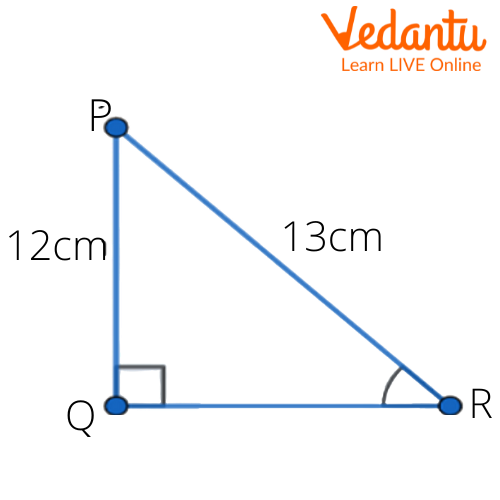
Ans: Given in the figure,
$PQ=12\text{ cm}$
$PQ=13\text{ cm}$
We know that for right triangle
$\tan \theta =\dfrac{\text{opposite side}}{\text{adjacent side}}$ and
$\cot \theta =\dfrac{\text{adjacent side}}{\text{opposite side}}$
Now, we need to apply the Pythagoras theorem to find the measure of adjacent side/base.
In $\Delta PQR$, by Pythagoras theorem ,
${{\left( \text{hypotenuse} \right)}^{2}}={{\left( base \right)}^{2}}+{{\left( perpendicular \right)}^{2}}$
We get
$\Rightarrow {{\left( PR \right)}^{2}}={{\left( PQ \right)}^{2}}+{{\left( QR \right)}^{2}}$
$\Rightarrow {{\left( 13 \right)}^{2}}={{\left( 12 \right)}^{2}}+{{\left( QR \right)}^{2}}$
$\Rightarrow 169=144+{{\left( QR \right)}^{2}}$
$\Rightarrow {{\left( QR \right)}^{2}}=169-144$
$\Rightarrow {{\left( QR \right)}^{2}}=25\text{ }c{{m}^{2}}$
$\Rightarrow QR=5\text{ cm}$
Now,
$\tan P=\dfrac{\text{opposite side}}{\text{adjacent side}}$
$\Rightarrow \tan P=\dfrac{QR}{PQ}$
$\therefore \tan P=\dfrac{5}{12}$
$\cot R=\dfrac{\text{adjacent side}}{\text{opposite side}}$
$\Rightarrow \cot R=\dfrac{QR}{PQ}$
$\therefore \cot R=\dfrac{5}{12}$
$\Rightarrow \tan P-\cot R=\dfrac{5}{12}-\dfrac{5}{12}$
$\therefore \tan P-\cot R=0$
3. If $\sin A=\dfrac{3}{4}$, calculate $\cos A$ and $\tan A$.
Ans: Let us consider a right angled triangle $\Delta ABC$. We get
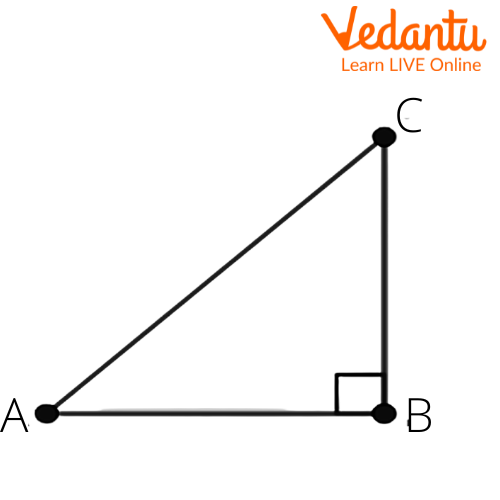
Given that $\sin A=\dfrac{3}{4}$.
We know that $\sin \theta =\dfrac{\text{opposite side}}{\text{hypotenuse}}$.
From the above figure, we get
$\sin A=\dfrac{BC}{AC}$
Therefore, we get
$\Rightarrow BC=3$ and
$\Rightarrow AC=4$
Now, we have to find the values of $\cos A$ and $\tan A$.
We know that $\cos \theta =\dfrac{\text{adjacent side}}{\text{hypotenuse}}$ and $\tan \theta =\dfrac{\text{opposite side}}{\text{adjacent side}}$.
Now, we need to apply the Pythagoras theorem to find the measure of adjacent side/base.
In $\Delta ABC$, by Pythagoras theorem ,
${{\left( \text{hypotenuse} \right)}^{2}}={{\left( base \right)}^{2}}+{{\left( perpendicular \right)}^{2}}$
Here, $AC=4\text{ cm}$, $BC=3\text{ cm}$
We get
$\Rightarrow {{\left( \text{AC} \right)}^{2}}={{\left( AB \right)}^{2}}+{{\left( BC \right)}^{2}}$
$\Rightarrow {{4}^{2}}=A{{B}^{2}}+{{3}^{2}}$
$\Rightarrow 16=A{{B}^{2}}+9$
$\Rightarrow A{{B}^{2}}=16-9$
$\Rightarrow A{{B}^{2}}=7$
$\Rightarrow AB=\sqrt{7}\text{ cm}$
Now, we get
$\cos A=\dfrac{AB}{AC}$
$\therefore \cos A=\dfrac{\sqrt{7}}{4}$
And $\tan A=\dfrac{BC}{AB}$
$\therefore \tan A=\dfrac{3}{\sqrt{7}}$
4. Given $15\cot A=8$. Find $\sin A$ and $\sec A$.
Ans: Let us consider a right angled triangle $\Delta ABC$. We get
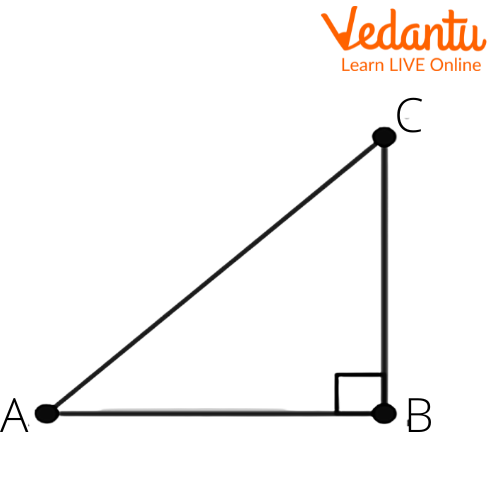
Given that $15\cot A=8$.
We get $\cot A=\dfrac{8}{15}$.
We know that $\cot \theta =\dfrac{\text{adjacent side}}{\text{opposite side}}$.
From the above figure, we get
$\cot A=\dfrac{AB}{BC}$
Therefore, we get
$\Rightarrow BC=15$ and
$\Rightarrow AB=8$
Now, we have to find the values of $\sin A$ and $\sec A$.
We know that $\sin \theta =\dfrac{\text{opposite side}}{\text{hypotenuse}}$ and $\sec \theta =\dfrac{\text{hypotenuse}}{\text{adjacent side}}$.
Now, we need to apply the Pythagoras theorem to find the measure of hypotenuse.
In $\Delta ABC$, by Pythagoras theorem ,
${{\left( \text{hypotenuse} \right)}^{2}}={{\left( base \right)}^{2}}+{{\left( perpendicular \right)}^{2}}$
We get
$\Rightarrow {{\left( \text{AC} \right)}^{2}}={{\left( AB \right)}^{2}}+{{\left( BC \right)}^{2}}$
$\Rightarrow A{{C}^{2}}={{8}^{2}}+{{15}^{2}}$
$\Rightarrow A{{C}^{2}}=64+225$
$\Rightarrow A{{C}^{2}}=289$
$\Rightarrow AC=17\text{ cm}$
Now, we get
$\sin A=\dfrac{BC}{AC}$
$\therefore \sin A=\dfrac{15}{17}$
And $\sec A=\dfrac{AC}{AB}$
$\therefore \sec A=\dfrac{17}{8}$
5. Given $\sec \theta =\dfrac{13}{12}$, calculate all other trigonometric ratios.
Ans: Let us consider a right angled triangle $\Delta ABC$. We get
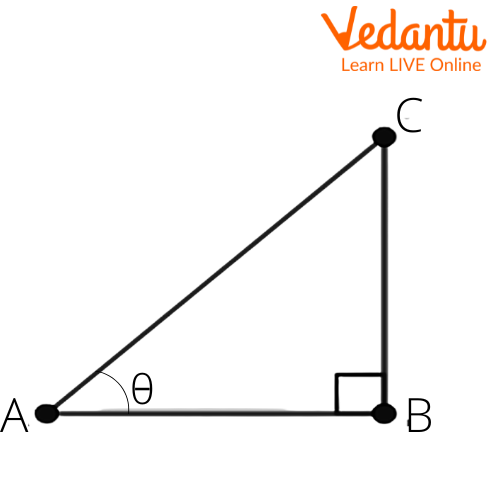
Given that $\sec \theta =\dfrac{13}{12}$.
We know that $\sec \theta =\dfrac{\text{hypotenuse}}{\text{adjacent side}}$.
From the above figure, we get
$\sec \theta =\dfrac{AC}{AB}$
Therefore, we get
$\Rightarrow AC=13$ and
$\Rightarrow AB=12$
Now, we need to apply the Pythagoras theorem to find the measure of the perpendicular/opposite side.
In $\Delta ABC$, by Pythagoras theorem ,
${{\left( \text{hypotenuse} \right)}^{2}}={{\left( base \right)}^{2}}+{{\left( perpendicular \right)}^{2}}$
We get
$\Rightarrow {{\left( \text{AC} \right)}^{2}}={{\left( AB \right)}^{2}}+{{\left( BC \right)}^{2}}$
$\Rightarrow {{13}^{2}}={{12}^{2}}+B{{C}^{2}}$
$\Rightarrow 169=144+B{{C}^{2}}$
$\Rightarrow B{{C}^{2}}=25$
$\Rightarrow BC=5\text{ cm}$
Now, we know that
$\sin \theta =\dfrac{\text{opposite side}}{\text{hypotenuse}}$
Here, $\sin \theta =\dfrac{BC}{AC}$
$\therefore \sin \theta =\dfrac{5}{13}$
We know that $\cos \theta =\dfrac{\text{adjacent side}}{\text{hypotenuse}}$
Here, $\cos \theta =\dfrac{AB}{AC}$
$\therefore \cos \theta =\dfrac{12}{13}$
We know that $\tan \theta =\dfrac{\text{opposite side}}{\text{adjacent side}}$
Here, $\tan \theta =\dfrac{BC}{AB}$
$\therefore \tan \theta =\dfrac{5}{12}$
We know that $\operatorname{cosec}\theta =\dfrac{\text{hypotenuse}}{\text{opposite side}}$
Here, $\operatorname{cosec}\theta =\dfrac{AC}{BC}$
$\therefore \operatorname{cosec}\theta =\dfrac{13}{5}$
We know that $\cot \theta =\dfrac{\text{adjacent side}}{\text{opposite side}}$
Here, $\cot \theta =\dfrac{\text{AB}}{BC}$
\[\therefore \cot \theta =\dfrac{12}{5}\] .
6. If $\angle A$ and $\angle B$ are acute angles such that $\cos A=\cos B$, then show that $\angle A=\angle B$.
Ans: Let us consider a right angled triangle $\Delta ABC$. We get

Given that $\cos A=\cos B$.
In a right triangle $\Delta ABC$, we know that
$\cos \theta =\dfrac{\text{adjacent side}}{\text{hypotenuse}}$
Here,
$\cos A=\dfrac{AC}{AB}$
And $\cos B=\dfrac{BC}{AB}$
As given $\cos A=\cos B$, we get
$\Rightarrow \dfrac{AC}{AB}=\dfrac{BC}{AB}$
$\Rightarrow AC=AB$
Now, we know that angles opposite to the equal sides are also equal in measure.
Then, we get
$\angle A=\angle B$
Hence proved.
7. Evaluate the following if $\cot \theta =\dfrac{7}{8}$
(i) $\dfrac{\left( 1+\sin \theta \right)\left( 1-\sin \theta \right)}{\left( 1+\cos \theta \right)\left( 1-\cos \theta \right)}$
Ans: Let us consider a right angled triangle $\Delta ABC$. We get

Now, in a right triangle we know that $\cot \theta =\dfrac{\text{adjacent side}}{\text{opposite side}}$.
Here, from the figure $\cot \theta =\dfrac{BC}{AB}$ .
We get
$AB=8$ and
$BC=7$
Now, we need to apply the Pythagoras theorem to find the measure of hypotenuse.
In $\Delta ABC$, by Pythagoras theorem ,
${{\left( \text{hypotenuse} \right)}^{2}}={{\left( base \right)}^{2}}+{{\left( perpendicular \right)}^{2}}$
We get
$\Rightarrow {{\left( \text{AC} \right)}^{2}}={{\left( AB \right)}^{2}}+{{\left( BC \right)}^{2}}$
$\Rightarrow {{\left( \text{AC} \right)}^{2}}={{8}^{2}}+{{7}^{2}}$
$\Rightarrow {{\left( \text{AC} \right)}^{2}}=64+49$
$\Rightarrow {{\left( \text{AC} \right)}^{2}}=113$
$\Rightarrow AC=\sqrt{113}$
Now, we know that
$\sin \theta =\dfrac{\text{opposite side}}{\text{hypotenuse}}$
Here, we get
$\sin \theta =\dfrac{AB}{AC}=\dfrac{8}{\sqrt{113}}$ and
$\cos \theta =\dfrac{\text{adjacent side}}{\text{hypotenuse}}$
Here, we get
$\cos \theta =\dfrac{BC}{AC}=\dfrac{7}{\sqrt{113}}$
Now, we have to evaluate
$\dfrac{\left( 1+\sin \theta \right)\left( 1-\sin \theta \right)}{\left( 1+\cos \theta \right)\left( 1-\cos \theta \right)}$
Applying the identity $\left( a+b \right)\left( a-b \right)={{a}^{2}}-{{b}^{2}}$, we get
\[\Rightarrow \dfrac{\left( 1+\sin \theta \right)\left( 1-\sin \theta \right)}{\left( 1+\cos \theta \right)\left( 1-\cos \theta \right)}=\dfrac{1-{{\sin }^{2}}\theta }{1-{{\cos }^{2}}\theta }\]
Substituting the values, we get
\[\Rightarrow \dfrac{\left( 1+\sin \theta \right)\left( 1-\sin \theta \right)}{\left( 1+\cos \theta \right)\left( 1-\cos \theta \right)}=\dfrac{1-{{\left( \dfrac{8}{\sqrt{113}} \right)}^{2}}}{1-{{\left( \dfrac{7}{\sqrt{113}} \right)}^{2}}}\]
\[\Rightarrow \dfrac{\left( 1+\sin \theta \right)\left( 1-\sin \theta \right)}{\left( 1+\cos \theta \right)\left( 1-\cos \theta \right)}=\dfrac{1-\dfrac{64}{113}}{1-\dfrac{49}{113}}\]
\[\Rightarrow \dfrac{\left( 1+\sin \theta \right)\left( 1-\sin \theta \right)}{\left( 1+\cos \theta \right)\left( 1-\cos \theta \right)}=\dfrac{\dfrac{113-64}{113}}{\dfrac{113-49}{113}}\]
\[\Rightarrow \dfrac{\left( 1+\sin \theta \right)\left( 1-\sin \theta \right)}{\left( 1+\cos \theta \right)\left( 1-\cos \theta \right)}=\dfrac{\dfrac{49}{113}}{\dfrac{64}{113}}\]
\[\therefore \dfrac{\left( 1+\sin \theta \right)\left( 1-\sin \theta \right)}{\left( 1+\cos \theta \right)\left( 1-\cos \theta \right)}=\dfrac{49}{64}\]
(ii) ${{\cot }^{2}}\theta $
Ans: Given that $\cot \theta =\dfrac{7}{8}$.
Now, ${{\cot }^{2}}\theta ={{\left( \dfrac{7}{8} \right)}^{2}}$
$\therefore {{\cot }^{2}}\theta =\dfrac{49}{64}$
8. If $3\cot A=4$, check whether $\dfrac{1-{{\tan }^{2}}A}{1+{{\tan }^{2}}A}={{\cos }^{2}}A-{{\sin }^{2}}A$ or not.
Ans: Let us consider a right angled triangle $\Delta ABC$. We get

Given that $3\cot A=4$.
We get $\cot A=\dfrac{4}{3}$.
We know that $\cot \theta =\dfrac{\text{adjacent side}}{\text{opposite side}}$.
From the above figure, we get
$\cot A=\dfrac{AB}{BC}$
Therefore, we get
$\Rightarrow BC=3$ and
$\Rightarrow AB=4$
Now, we need to apply the Pythagoras theorem to find the measure of hypotenuse.
In $\Delta ABC$, by Pythagoras theorem ,
${{\left( \text{hypotenuse} \right)}^{2}}={{\left( base \right)}^{2}}+{{\left( perpendicular \right)}^{2}}$
We get
$\Rightarrow {{\left( \text{AC} \right)}^{2}}={{\left( AB \right)}^{2}}+{{\left( BC \right)}^{2}}$
$\Rightarrow A{{C}^{2}}={{4}^{2}}+{{3}^{2}}$
$\Rightarrow A{{C}^{2}}=16+9$
$\Rightarrow A{{C}^{2}}=25$
$\Rightarrow AC=5$
Now, let us consider LHS of the expression $\dfrac{1-{{\tan }^{2}}A}{1+{{\tan }^{2}}A}={{\cos }^{2}}A-{{\sin }^{2}}A$, we get
$LHS=\dfrac{1-{{\tan }^{2}}A}{1+{{\tan }^{2}}A}$
Now, we know that $\tan \theta =\dfrac{\text{opposite side}}{\text{adjacent side}}$
Here, we get
$\tan A=\dfrac{BC}{AB}=\dfrac{3}{4}$
Substitute the value, we get
$\Rightarrow \dfrac{1-{{\tan }^{2}}A}{1+{{\tan }^{2}}A}=\dfrac{1-{{\left( \dfrac{3}{4} \right)}^{2}}}{1+{{\left( \dfrac{3}{4} \right)}^{2}}}$
$\Rightarrow \dfrac{1-{{\tan }^{2}}A}{1+{{\tan }^{2}}A}=\dfrac{1-\dfrac{9}{16}}{1+\dfrac{9}{16}}$
$\Rightarrow \dfrac{1-{{\tan }^{2}}A}{1+{{\tan }^{2}}A}=\dfrac{\dfrac{16-9}{16}}{\dfrac{16+9}{16}}$
$\Rightarrow \dfrac{1-{{\tan }^{2}}A}{1+{{\tan }^{2}}A}=\dfrac{\dfrac{7}{16}}{\dfrac{25}{16}}$
$\Rightarrow \dfrac{1-{{\tan }^{2}}A}{1+{{\tan }^{2}}A}=\dfrac{7}{25}$
Now, let us consider RHS of the expression $\dfrac{1-{{\tan }^{2}}A}{1+{{\tan }^{2}}A}={{\cos }^{2}}A-{{\sin }^{2}}A$, we get
$RHS={{\cos }^{2}}A-{{\sin }^{2}}A$
We know that $\sin \theta =\dfrac{\text{opposite side}}{\text{hypotenuse}}$ and $\cos \theta =\dfrac{\text{adjacent side}}{\text{hypotenuse}}$.
Here, we get
$\sin A=\dfrac{BC}{AC}=\dfrac{3}{5}$
And $\cos A=\dfrac{AB}{AC}=\dfrac{4}{5}$
Substitute the values, we get
$\Rightarrow {{\cos }^{2}}A-{{\sin }^{2}}A={{\left( \dfrac{4}{5} \right)}^{2}}-{{\left( \dfrac{3}{5} \right)}^{2}}$
$\Rightarrow {{\cos }^{2}}A-{{\sin }^{2}}A=\dfrac{16}{25}-\dfrac{9}{25}$
$\Rightarrow {{\cos }^{2}}A-{{\sin }^{2}}A=\dfrac{7}{25}$
Hence, we get LHS=RHS
$\therefore \dfrac{1-{{\tan }^{2}}A}{1+{{\tan }^{2}}A}={{\cos }^{2}}A-{{\sin }^{2}}A$.
9. In $ABC$, right angled at $B$. If $\tan A=\dfrac{1}{\sqrt{3}}$, find the value of
(i) $\sin A\cos C+\cos A\sin C$
Ans: Let us consider a right angled triangle $\Delta ABC$. We get

Given that $\tan A=\dfrac{1}{\sqrt{3}}$.
In a right triangle, we know that $\tan \theta =\dfrac{\text{opposite side}}{\text{adjacent side}}$
Here, from the figure we get
$\tan A=\dfrac{BC}{AB}=\dfrac{1}{\sqrt{3}}$
We get $BC=1$ and $AB=\sqrt{3}$ .
Now, we need to apply the Pythagoras theorem to find the measure of hypotenuse.
In $\Delta ABC$, by Pythagoras theorem ,
${{\left( \text{hypotenuse} \right)}^{2}}={{\left( base \right)}^{2}}+{{\left( perpendicular \right)}^{2}}$
We get
$\Rightarrow {{\left( \text{AC} \right)}^{2}}={{\left( AB \right)}^{2}}+{{\left( BC \right)}^{2}}$
$\Rightarrow A{{C}^{2}}={{\left( \sqrt{3} \right)}^{2}}+{{1}^{2}}$
$\Rightarrow A{{C}^{2}}=3+1$
$\Rightarrow A{{C}^{2}}=4$
$\Rightarrow AC=2$
We know that $\sin \theta =\dfrac{\text{opposite side}}{\text{hypotenuse}}$ and $\cos \theta =\dfrac{\text{adjacent side}}{\text{hypotenuse}}$.
Here, we get
$\sin A=\dfrac{BC}{AC}=\dfrac{1}{2}$ and $\sin C=\dfrac{AB}{AC}=\dfrac{\sqrt{3}}{2}$
And $\cos A=\dfrac{AB}{AC}=\dfrac{\sqrt{3}}{2}$and $\cos C=\dfrac{BC}{AC}=\dfrac{1}{2}$
Now, we have to find the value of the expression $\sin A\cos C+\cos A\sin C$.
Substituting the values we get
$\Rightarrow \sin A\cos C+\cos A\sin C=\dfrac{1}{2}\times \dfrac{1}{2}+\dfrac{\sqrt{3}}{2}\times \dfrac{\sqrt{3}}{2}$
$\Rightarrow \sin A\cos C+\cos A\sin C=\dfrac{1}{4}+\dfrac{3}{4}$
$\Rightarrow \sin A\cos C+\cos A\sin C=\dfrac{4}{4}$
$\therefore \sin A\cos C+\cos A\sin C=1$
(ii) $\cos A\cos C-\sin A\sin C$
Ans: Let us consider a right angled triangle $\Delta ABC$. We get

Given that $\tan A=\dfrac{1}{\sqrt{3}}$.
In a right triangle, we know that $\tan \theta =\dfrac{\text{opposite side}}{\text{adjacent side}}$
Here, from the figure we get
$\tan A=\dfrac{BC}{AB}=\dfrac{1}{\sqrt{3}}$
We get $BC=1$ and $AB=\sqrt{3}$ .
Now, we need to apply the Pythagoras theorem to find the measure of hypotenuse.
In $\Delta ABC$, by Pythagoras theorem ,
${{\left( \text{hypotenuse} \right)}^{2}}={{\left( base \right)}^{2}}+{{\left( perpendicular \right)}^{2}}$
We get
$\Rightarrow {{\left( \text{AC} \right)}^{2}}={{\left( AB \right)}^{2}}+{{\left( BC \right)}^{2}}$
$\Rightarrow A{{C}^{2}}={{\left( \sqrt{3} \right)}^{2}}+{{1}^{2}}$
$\Rightarrow A{{C}^{2}}=3+1$
$\Rightarrow A{{C}^{2}}=4$
$\Rightarrow AC=2$
We know that $\sin \theta =\dfrac{\text{opposite side}}{\text{hypotenuse}}$ and $\cos \theta =\dfrac{\text{adjacent side}}{\text{hypotenuse}}$.
Here, we get
$\sin A=\dfrac{BC}{AC}=\dfrac{1}{2}$ and $\sin C=\dfrac{AB}{AC}=\dfrac{\sqrt{3}}{2}$
And $\cos A=\dfrac{AB}{AC}=\dfrac{\sqrt{3}}{2}$and $\cos C=\dfrac{BC}{AC}=\dfrac{1}{2}$
Now, we have to find the value of the expression $\cos A\cos C-\sin A\sin C$.
Substituting the values we get
$\Rightarrow \cos A\cos C-\sin A\sin C=\dfrac{\sqrt{3}}{2}\times \dfrac{1}{2}-\dfrac{1}{2}\times \dfrac{\sqrt{3}}{2}$
$\Rightarrow \cos A\cos C-\sin A\sin C=\dfrac{\sqrt{3}}{4}-\dfrac{\sqrt{3}}{4}$
$\therefore \Rightarrow \cos A\cos C-\sin A\sin C=0$
10. In $\Delta PQR$, right angled at $Q$, $PR+QR=25\text{ cm}$ and $PQ=5\text{ cm}$. Determine the values of $\sin P,\cos P$ and $\tan P$.
Ans: Let us consider a right angled triangle $\Delta PQR$, we get

Given that $PR+QR=25\text{ cm}$ and $PQ=5\text{ cm}$.
Let $QR=25-PR$
Now, applying the Pythagoras theorem in $\Delta PQR$, we get
${{\left( \text{hypotenuse} \right)}^{2}}={{\left( base \right)}^{2}}+{{\left( perpendicular \right)}^{2}}$
We get
$\Rightarrow {{\left( PR \right)}^{2}}={{\left( PQ \right)}^{2}}+{{\left( QR \right)}^{2}}$
$\Rightarrow P{{R}^{2}}={{5}^{2}}+{{\left( 25-PR \right)}^{2}}$
$\Rightarrow P{{R}^{2}}=25+{{25}^{2}}+P{{R}^{2}}-50PR$
$\Rightarrow P{{R}^{2}}=P{{R}^{2}}+25+625-50PR$
$\Rightarrow 50PR=650$
$\Rightarrow PR=13\text{ cm}$
Therefore,
$QR=25-13$
$\Rightarrow QR=12\text{ cm}$
Now, we know that in right triangle,
$\sin \theta =\dfrac{\text{opposite side}}{\text{hypotenuse}}$, $\cos \theta =\dfrac{\text{adjacent side}}{\text{hypotenuse}}$ and $\tan \theta =\dfrac{\text{opposite side}}{\text{adjacent side}}$.
Here, we get
$\sin P=\dfrac{QR}{PR}$
$\therefore \sin P=\dfrac{12}{13}$
$\cos P=\dfrac{PQ}{PR}$
$\therefore \cos P=\dfrac{5}{13}$
$\tan P=\dfrac{QR}{PQ}$
$\therefore \tan P=\dfrac{12}{5}$
11. State whether the following are true or false. Justify your answer.
(i) The value of $\tan A$ is always less than $1$.
Ans: The given statement is false. The value of $\tan A$ depends on the length of sides of a right triangle and sides of a triangle may have any measure.
(ii) For some value of angle $A$, $\sec A=\dfrac{12}{5}$.
Ans: We know that in the right triangle $\sec A=\dfrac{\text{hypotenuse}}{\text{adjacent side of }\angle \text{A}}$ .
We know that in the right triangle the hypotenuse is the largest side.
Therefore, the value of $\sec A$ must be greater than $1$.
In the given statement $\sec A=\dfrac{12}{5}$, which is greater than $1$.
Therefore, the given statement is true.
(iii) $\cos A$ is the abbreviation used for the cosecant of angle $A$.
Ans: The given statement is false because $\cos A$ is the abbreviation used for the cosine of angle $A$. Abbreviation used for the cosecant of angle $A$ is $\operatorname{cosec}A$.
(iv) $\cot A$ is the product of $\cot $ and $A$.
Ans: $\cot A$ is the abbreviation used for the cotangent of angle $A$. Hence the given statement is false.
(v) For some angle $\theta $, $\sin \theta =\dfrac{4}{3}$.
Ans: We know that in the right triangle $\sin \theta =\dfrac{\text{opposite side}}{\text{hypotenuse}}$ .
We know that in the right triangle the hypotenuse is the largest side.
Therefore, the value of $\sin \theta $ must be less than $1$.
In the given statement $\sin \theta =\dfrac{4}{3}$, which is greater than $1$.
Therefore, the given statement is false.
Exercise 8.2
1. Evaluate the following:
(i) $\sin 60{}^\circ \cos 30{}^\circ +\sin 30{}^\circ \cos 60{}^\circ $
Ans: With the help of trigonometric ratio tables we can find the values of standard trigonometric angles. The trigonometric ratio table is as follows:
Exact Values of Trigonometric Functions | ||||
Angle $\theta $ | $\sin \theta $ | $\cos \theta $ | $\tan \theta $ | |
Degrees | Radians | |||
$0{}^\circ $ | $0$ | $0$ | $1$ | $0$ |
$30{}^\circ $ | $\dfrac{\pi }{6}$ | $\dfrac{1}{2}$ | $\dfrac{\sqrt{3}}{2}$ | $\dfrac{1}{\sqrt{3}}$ |
$45{}^\circ $ | $\dfrac{\pi }{4}$ | $\dfrac{1}{\sqrt{2}}$ | $\dfrac{1}{\sqrt{2}}$ | $1$ |
$60{}^\circ $ | $\dfrac{\pi }{3}$ | $\dfrac{\sqrt{3}}{2}$ | $\dfrac{1}{2}$ | $\sqrt{3}$ |
$90{}^\circ $ | $\dfrac{\pi }{2}$ | $1$ | $0$ | Not defined |
We have to evaluate $\sin 60{}^\circ \cos 30{}^\circ +\sin 30{}^\circ \cos 60{}^\circ $.
Substitute the values from the above table, we get
$\Rightarrow \dfrac{\sqrt{3}}{2}\times \dfrac{\sqrt{3}}{2}+\dfrac{1}{2}\times \dfrac{1}{2}$
$\Rightarrow \dfrac{3}{4}+\dfrac{1}{4}$
$\Rightarrow \dfrac{4}{4}$
$\therefore \sin 60{}^\circ \cos 30{}^\circ +\sin 30{}^\circ \cos 60{}^\circ =1$.
(ii) $2{{\tan }^{2}}45{}^\circ +{{\cos }^{2}}30{}^\circ -{{\sin }^{2}}60{}^\circ $
Ans: With the help of trigonometric ratio tables we can find the values of standard trigonometric angles. The trigonometric ratio table is as follows:
Exact Values of Trigonometric Functions | ||||
Angle $\theta $ | $\sin \theta $ | $\cos \theta $ | $\tan \theta $ | |
Degrees | Radians | |||
$0{}^\circ $ | $0$ | $0$ | $1$ | $0$ |
$30{}^\circ $ | $\dfrac{\pi }{6}$ | $\dfrac{1}{2}$ | $\dfrac{\sqrt{3}}{2}$ | $\dfrac{1}{\sqrt{3}}$ |
$45{}^\circ $ | $\dfrac{\pi }{4}$ | $\dfrac{1}{\sqrt{2}}$ | $\dfrac{1}{\sqrt{2}}$ | $1$ |
$60{}^\circ $ | $\dfrac{\pi }{3}$ | $\dfrac{\sqrt{3}}{2}$ | $\dfrac{1}{2}$ | $\sqrt{3}$ |
$90{}^\circ $ | $\dfrac{\pi }{2}$ | $1$ | $0$ | Not defined |
We have to evaluate $2{{\tan }^{2}}45{}^\circ +{{\cos }^{2}}30{}^\circ -{{\sin }^{2}}60{}^\circ $.
Substitute the values from the above table, we get
$\Rightarrow 2{{\left( 1 \right)}^{2}}+{{\left( \dfrac{\sqrt{3}}{2} \right)}^{2}}-{{\left( \dfrac{\sqrt{3}}{2} \right)}^{2}}$
$\Rightarrow 2+\dfrac{3}{4}-\dfrac{3}{4}$
$\Rightarrow 2$
$\therefore 2{{\tan }^{2}}45{}^\circ +{{\cos }^{2}}30{}^\circ -{{\sin }^{2}}60{}^\circ =2$.
(iii) $\dfrac{\cos 45{}^\circ }{\sec 30{}^\circ +\operatorname{cosec}30{}^\circ }$
Ans: With the help of trigonometric ratio tables we can find the values of standard trigonometric angles. The trigonometric ratio table is as follows:
Exact Values of Trigonometric Functions | ||||
Angle $\theta $ | $\sin \theta $ | $\cos \theta $ | $\tan \theta $ | |
Degrees | Radians | |||
$0{}^\circ $ | $0$ | $0$ | $1$ | $0$ |
$30{}^\circ $ | $\dfrac{\pi }{6}$ | $\dfrac{1}{2}$ | $\dfrac{\sqrt{3}}{2}$ | $\dfrac{1}{\sqrt{3}}$ |
$45{}^\circ $ | $\dfrac{\pi }{4}$ | $\dfrac{1}{\sqrt{2}}$ | $\dfrac{1}{\sqrt{2}}$ | $1$ |
$60{}^\circ $ | $\dfrac{\pi }{3}$ | $\dfrac{\sqrt{3}}{2}$ | $\dfrac{1}{2}$ | $\sqrt{3}$ |
$90{}^\circ $ | $\dfrac{\pi }{2}$ | $1$ | $0$ | Not defined |
We have to evaluate $\dfrac{\cos 45{}^\circ }{\sec 30{}^\circ +\operatorname{cosec}30{}^\circ }$.
Substitute the values from the above table, we get
$\Rightarrow \dfrac{\dfrac{1}{\sqrt{2}}}{\dfrac{2}{\sqrt{3}}+2}$
$\Rightarrow \dfrac{\dfrac{1}{\sqrt{2}}}{\dfrac{2+2\sqrt{3}}{\sqrt{3}}}$
\[\Rightarrow \dfrac{1}{\sqrt{2}}\times \dfrac{\sqrt{3}}{2+2\sqrt{3}}\]
Multiplying and dividing by \[\sqrt{3}-1\], we get
\[\Rightarrow \dfrac{1}{\sqrt{2}}\times \dfrac{\sqrt{3}}{2+2\sqrt{3}}\times \dfrac{\sqrt{3}-1}{\sqrt{3}-1}\]
\[\Rightarrow \dfrac{\sqrt{3}\left( \sqrt{3}-1 \right)}{\sqrt{2}\left( 2+2\sqrt{3} \right)\left( \sqrt{3}-1 \right)}\]
\[\Rightarrow \dfrac{\sqrt{3}\left( \sqrt{3}-1 \right)}{2\sqrt{2}\left( \sqrt{3}+1 \right)\left( \sqrt{3}-1 \right)}\]
\[\Rightarrow \dfrac{3-\sqrt{3}}{2\sqrt{2}\left( {{\left( \sqrt{3} \right)}^{2}}-{{1}^{2}} \right)}\]
\[\Rightarrow \dfrac{3-\sqrt{3}}{2\sqrt{2}\left( 3-1 \right)}\]
$\Rightarrow \dfrac{3-\sqrt{3}}{4\sqrt{2}}$
$\therefore \dfrac{\cos 45{}^\circ }{\sec 30{}^\circ +\operatorname{cosec}30{}^\circ }=\dfrac{3-\sqrt{3}}{4\sqrt{2}}$
(iv) $\dfrac{\sin 30{}^\circ +\tan 45{}^\circ -\operatorname{cosec}60{}^\circ }{\sec 30{}^\circ +\cos 60{}^\circ -\cot 45{}^\circ }$
Ans: With the help of trigonometric ratio tables we can find the values of standard trigonometric angles. The trigonometric ratio table is as follows:
Exact Values of Trigonometric Functions | ||||
Angle $\theta $ | $\sin \theta $ | $\cos \theta $ | $\tan \theta $ | |
Degrees | Radians | |||
$0{}^\circ $ | $0$ | $0$ | $1$ | $0$ |
$30{}^\circ $ | $\dfrac{\pi }{6}$ | $\dfrac{1}{2}$ | $\dfrac{\sqrt{3}}{2}$ | $\dfrac{1}{\sqrt{3}}$ |
$45{}^\circ $ | $\dfrac{\pi }{4}$ | $\dfrac{1}{\sqrt{2}}$ | $\dfrac{1}{\sqrt{2}}$ | $1$ |
$60{}^\circ $ | $\dfrac{\pi }{3}$ | $\dfrac{\sqrt{3}}{2}$ | $\dfrac{1}{2}$ | $\sqrt{3}$ |
$90{}^\circ $ | $\dfrac{\pi }{2}$ | $1$ | $0$ | Not defined |
We have to evaluate $\dfrac{\sin 30{}^\circ +\tan 45{}^\circ -\operatorname{cosec}60{}^\circ }{\sec 30{}^\circ +\cos 60{}^\circ -\cot 45{}^\circ }$.
Substitute the values from the above table, we get
$\Rightarrow \dfrac{\dfrac{1}{2}+1-\dfrac{2}{\sqrt{3}}}{\dfrac{2}{\sqrt{3}}+\dfrac{1}{2}+1}$
$\Rightarrow \dfrac{\dfrac{3}{2}-\dfrac{2}{\sqrt{3}}}{\dfrac{2}{\sqrt{3}}+\dfrac{3}{2}}$
$\Rightarrow \dfrac{\dfrac{3\sqrt{3}-4}{2\sqrt{3}}}{\dfrac{3\sqrt{3}+4}{2\sqrt{3}}}$
$\Rightarrow \dfrac{3\sqrt{3}-4}{3\sqrt{3}+4}$
Multiplying and dividing by \[3\sqrt{3}-4\], we get
\[\Rightarrow \dfrac{3\sqrt{3}-4}{3\sqrt{3}+4}\times \dfrac{3\sqrt{3}-4}{3\sqrt{3}-4}\]
Now, applying the identity $\left( a+b \right)\left( a-b \right)={{a}^{2}}-{{b}^{2}}$, we get
\[\Rightarrow \dfrac{{{\left( 3\sqrt{3}-4 \right)}^{2}}}{{{\left( 3\sqrt{3} \right)}^{2}}-{{4}^{2}}}\]
\[\Rightarrow \dfrac{{{\left( 3\sqrt{3}-4 \right)}^{2}}}{{{\left( 3\sqrt{3} \right)}^{2}}-{{4}^{2}}}\]
\[\Rightarrow \dfrac{27+16-24\sqrt{3}}{27-16}\]
$\Rightarrow \dfrac{43-24\sqrt{3}}{11}$
$\therefore \dfrac{\sin 30{}^\circ +\tan 45{}^\circ -\operatorname{cosec}60{}^\circ }{\sec 30{}^\circ +\cos 60{}^\circ -\cot 45{}^\circ }=\dfrac{43-24\sqrt{3}}{11}$
(v) $\dfrac{5{{\cos }^{2}}60{}^\circ +4{{\sec }^{2}}30{}^\circ -{{\tan }^{2}}45{}^\circ }{{{\sec }^{2}}30{}^\circ +{{\cos }^{2}}30{}^\circ }$
Ans: With the help of trigonometric ratio tables we can find the values of standard trigonometric angles. The trigonometric ratio table is as follows:
Exact Values of Trigonometric Functions | ||||
Angle $\theta $ | $\sin \theta $ | $\cos \theta $ | $\tan \theta $ | |
Degrees | Radians | |||
$0{}^\circ $ | $0$ | $0$ | $1$ | $0$ |
$30{}^\circ $ | $\dfrac{\pi }{6}$ | $\dfrac{1}{2}$ | $\dfrac{\sqrt{3}}{2}$ | $\dfrac{1}{\sqrt{3}}$ |
$45{}^\circ $ | $\dfrac{\pi }{4}$ | $\dfrac{1}{\sqrt{2}}$ | $\dfrac{1}{\sqrt{2}}$ | $1$ |
$60{}^\circ $ | $\dfrac{\pi }{3}$ | $\dfrac{\sqrt{3}}{2}$ | $\dfrac{1}{2}$ | $\sqrt{3}$ |
$90{}^\circ $ | $\dfrac{\pi }{2}$ | $1$ | $0$ | Not defined |
We have to evaluate $\dfrac{5{{\cos }^{2}}60{}^\circ +4{{\sec }^{2}}30{}^\circ -{{\tan }^{2}}45{}^\circ }{{{\sec }^{2}}30{}^\circ +{{\cos }^{2}}30{}^\circ }$.
Substitute the values from the above table, we get
$\Rightarrow \dfrac{5{{\left( \dfrac{1}{2} \right)}^{2}}+4{{\left( \dfrac{2}{\sqrt{3}} \right)}^{2}}-{{1}^{2}}}{{{\left( \dfrac{1}{2} \right)}^{2}}+{{\left( \dfrac{\sqrt{3}}{2} \right)}^{2}}}$
$\Rightarrow \dfrac{5\left( \dfrac{1}{4} \right)+4\left( \dfrac{4}{3} \right)-1}{\left( \dfrac{1}{4} \right)+\left( \dfrac{3}{4} \right)}$
$\Rightarrow \dfrac{\dfrac{15+64-12}{12}}{\dfrac{1+3}{4}}$
$\Rightarrow \dfrac{\dfrac{15+64-12}{12}}{\dfrac{1+3}{4}}$
$\Rightarrow \dfrac{\dfrac{15+64-12}{12}}{\dfrac{4}{4}}$
$\Rightarrow \dfrac{\dfrac{67}{12}}{1}$
$\therefore \dfrac{5{{\cos }^{2}}60{}^\circ +4{{\sec }^{2}}30{}^\circ -{{\tan }^{2}}45{}^\circ }{{{\sec }^{2}}30{}^\circ +{{\cos }^{2}}30{}^\circ }=\dfrac{67}{12}$.
2. Choose the correct option and justify your choice.
(i) $\dfrac{2\tan 30{}^\circ }{1+{{\tan }^{2}}30{}^\circ }=$ ………
(a) $\sin 60{}^\circ $
(b) $\cos 60{}^\circ $
(c) $\tan 60{}^\circ $
(d) $\sin 30{}^\circ $
Ans: The given expression is $\dfrac{2\tan 30{}^\circ }{1+{{\tan }^{2}}30{}^\circ }$.
We know that from the trigonometric ratio table we have $\tan 30{}^\circ =\dfrac{1}{\sqrt{3}}$.
Substitute the value in the given expression we get
$\dfrac{2\tan 30{}^\circ }{1+{{\tan }^{2}}30{}^\circ }=\dfrac{2\left( \dfrac{1}{\sqrt{3}} \right)}{1+{{\left( \dfrac{1}{\sqrt{3}} \right)}^{2}}}$
$\Rightarrow \dfrac{2\tan 30{}^\circ }{1+{{\tan }^{2}}30{}^\circ }=\dfrac{\dfrac{2}{\sqrt{3}}}{1+\dfrac{1}{3}}$
$\Rightarrow \dfrac{2\tan 30{}^\circ }{1+{{\tan }^{2}}30{}^\circ }=\dfrac{\dfrac{2}{\sqrt{3}}}{\dfrac{4}{3}}$
$\Rightarrow \dfrac{2\tan 30{}^\circ }{1+{{\tan }^{2}}30{}^\circ }=\dfrac{\sqrt{3}}{2}$
From the trigonometric table we know that
$\sin 60{}^\circ =\dfrac{\sqrt{3}}{2}$
$\cos 60{}^\circ =\dfrac{1}{2}$
$\tan 60{}^\circ =\sqrt{3}$
$\sin 30{}^\circ =\dfrac{1}{2}$
Hence, $\dfrac{2\tan 30{}^\circ }{1+{{\tan }^{2}}30{}^\circ }=\sin 60{}^\circ $.
Therefore, option (A) is the correct answer.
(ii) $\dfrac{1-{{\tan }^{2}}45{}^\circ }{1+{{\tan }^{2}}45{}^\circ }=$ ………
(a) $\tan 90{}^\circ $
(b) $1$
(c) $\sin 45{}^\circ $
(d) $0$
Ans: The given expression is $\dfrac{1-{{\tan }^{2}}45{}^\circ }{1+{{\tan }^{2}}45{}^\circ }$.
We know that from the trigonometric ratio table we have $\tan 45{}^\circ =1$.
Substitute the value in the given expression we get
$\dfrac{1-{{\tan }^{2}}45{}^\circ }{1+{{\tan }^{2}}45{}^\circ }=\dfrac{1-{{1}^{2}}}{1+{{1}^{2}}}$
$\Rightarrow \dfrac{1-{{\tan }^{2}}45{}^\circ }{1+{{\tan }^{2}}45{}^\circ }=\dfrac{1-1}{1+1}$
$\Rightarrow \Rightarrow \dfrac{1-{{\tan }^{2}}45{}^\circ }{1+{{\tan }^{2}}45{}^\circ }=\dfrac{0}{2}$
$\therefore \dfrac{1-{{\tan }^{2}}45{}^\circ }{1+{{\tan }^{2}}45{}^\circ }=0$
Therefore, option (D) is the correct answer.
(iii) $\sin 2A=2\sin A$ is true when $A=$ ……..
(a) $0{}^\circ $
(b) $30{}^\circ $
(c) $45{}^\circ $
(d) $60{}^\circ $
Ans: The given expression is $\sin 2A=2\sin A$.
We know that from the trigonometric ratio table we have
$\sin 0{}^\circ =0$
$\sin 30{}^\circ =\dfrac{1}{2}$
$\sin 45{}^\circ =\dfrac{1}{\sqrt{2}}$
$\sin 60{}^\circ =\dfrac{\sqrt{3}}{2}$
$\sin 90{}^\circ =1$
The given statement is true when $A=0{}^\circ $.
Substitute the value in the given expression we get
$\Rightarrow \sin 2A=2\sin A$
$\Rightarrow \sin 2\times 0{}^\circ =2\sin 0{}^\circ $
$0=0$
Therefore, option (A) is the correct answer.
(iv) $\dfrac{2\tan 30{}^\circ }{1-{{\tan }^{2}}30{}^\circ }=$………
(a) $\sin 60{}^\circ $
(b) $\cos 60{}^\circ $
(c) $\tan 60{}^\circ $
(d) $\sin 30{}^\circ $
Ans: The given expression is $\dfrac{2\tan 30{}^\circ }{1-{{\tan }^{2}}30{}^\circ }$.
We know that from the trigonometric ratio table we have $\tan 30{}^\circ =\dfrac{1}{\sqrt{3}}$.
Substitute the value in the given expression we get
$\dfrac{2\tan 30{}^\circ }{1-{{\tan }^{2}}30{}^\circ }=\dfrac{2\left( \dfrac{1}{\sqrt{3}} \right)}{1-{{\left( \dfrac{1}{\sqrt{3}} \right)}^{2}}}$
$\Rightarrow \dfrac{2\tan 30{}^\circ }{1-{{\tan }^{2}}30{}^\circ }=\dfrac{\dfrac{2}{\sqrt{3}}}{1-\dfrac{1}{3}}$
$\Rightarrow \dfrac{2\tan 30{}^\circ }{1-{{\tan }^{2}}30{}^\circ }=\dfrac{\dfrac{2}{\sqrt{3}}}{\dfrac{2}{3}}$
$\Rightarrow \dfrac{2\tan 30{}^\circ }{1-{{\tan }^{2}}30{}^\circ }=\sqrt{3}$
From the trigonometric table we know that
$\sin 60{}^\circ =\dfrac{\sqrt{3}}{2}$
$\cos 60{}^\circ =\dfrac{1}{2}$
$\tan 60{}^\circ =\sqrt{3}$
$\sin 30{}^\circ =\dfrac{1}{2}$
Hence, $\dfrac{2\tan 30{}^\circ }{1-{{\tan }^{2}}30{}^\circ }=\tan 60{}^\circ $.
Therefore, option (C) is the correct answer.
3. If $\tan \left( A+B \right)=\sqrt{3}$ and $\tan \left( A-B \right)=\dfrac{1}{\sqrt{3}}$, $0{}^\circ <A+B\le 90{}^\circ $. Find $A$ and $B$.
Ans: Given that $\tan \left( A+ dB \right)=\sqrt{3}$ and $\tan \left( A-B \right)=\dfrac{1}{\sqrt{3}}$.
From the trigonometric ratio table we know that $\tan 60{}^\circ =\sqrt{3}$ and $\tan 30{}^\circ =\dfrac{1}{\sqrt{3}}$.
Then we get
$\tan \left( A+B \right)=\sqrt{3}$
$\Rightarrow \tan \left( A+B \right)=\tan 60{}^\circ $
$\Rightarrow A+B=60{}^\circ $ ……….(1)
Also, $\tan \left( A-B \right)=\dfrac{1}{\sqrt{3}}$
$\Rightarrow \tan \left( A-B \right)=\tan 30{}^\circ $
$\Rightarrow A-B=30{}^\circ $ ……….(2)
Adding eq. (1) and (2), we get
$2A=90{}^\circ $
$\therefore A=45{}^\circ $
Substitute the obtained value in eq. (1), we get
$45{}^\circ +B=60{}^\circ $
$\Rightarrow B=60{}^\circ -45{}^\circ $
$\therefore B=15{}^\circ $
Therefore, the values of $A$ and $B$ is $45{}^\circ $ and $15{}^\circ $ respectively.
4. State whether the following are true or false. Justify your answer.
(i) $\sin \left( A+B \right)=\sin A+\sin B$.
Ans: Let us assume $A=30{}^\circ $ and $B=60{}^\circ $.
Now, let us consider LHS of the given expression, we get
$\sin \left( A+B \right)$
Substitute the assumed values in the LHS, we get
$\sin \left( A+B \right)=\sin \left( 30{}^\circ +60{}^\circ \right)$
$\Rightarrow \sin \left( A+B \right)=\sin \left( 90{}^\circ \right)$
From the trigonometric ratio table we know that $\sin 90{}^\circ =1$, we get
$\Rightarrow \sin \left( A+B \right)=1$
Now, let us consider the RHS of the given expression and substitute the values, we get
$\sin A+\sin B=\sin 30{}^\circ +\sin 60{}^\circ $
From the trigonometric ratio table we know that $\sin 30{}^\circ =\dfrac{1}{2}$ and $\sin 60{}^\circ =\dfrac{\sqrt{3}}{2}$, we get
$\Rightarrow \sin A+\sin B=\dfrac{1}{2}+\dfrac{\sqrt{3}}{2}$
$\Rightarrow \sin A+\sin B=\dfrac{1+\sqrt{3}}{2}$
Thus, $LHS\ne RHS$.
Therefore, the given statement is false.
(ii) The value of $\sin \theta $ increases as $\theta $ increases.
Ans: The value of sine from the trigonometric ratio table is as follows:
$\sin 0{}^\circ =0$
$\sin 30{}^\circ =\dfrac{1}{2}=0.5$
$\sin 45{}^\circ =\dfrac{1}{\sqrt{2}}=0.707$
$\sin 60{}^\circ =\dfrac{\sqrt{3}}{2}=0.866$
$\sin 90{}^\circ =1$
Therefore, we can conclude that the value of $\sin \theta $ increases as $\theta $ increases.
Therefore, the given statement is true.
(iii) The value of $\cos \theta $ increases as $\theta $ increases.
Ans: The value of cosine from the trigonometric ratio table is as follows:
$\cos 0{}^\circ =1$
$\cos 30{}^\circ =\dfrac{\sqrt{3}}{2}=0.866$
$\cos 45{}^\circ =\dfrac{1}{\sqrt{2}}=0.707$
$\cos 60{}^\circ =\dfrac{1}{2}=0.5$
$\cos 90{}^\circ =0$
Therefore, we can conclude that the value of $\cos \theta $ decreases as $\theta $ increases.
Therefore, the given statement is false.
(iv) \[\sin \theta =\cos \theta \] for all values of \[\theta \].
Ans: The trigonometric ratio table is given as follows:
Exact Values of Trigonometric Functions | ||||
Angle $\theta $ | $\sin \theta $ | $\cos \theta $ | $\tan \theta $ | |
Degrees | Radians | |||
$0{}^\circ $ | $0$ | $0$ | $1$ | $0$ |
$30{}^\circ $ | $\dfrac{\pi }{6}$ | $\dfrac{1}{2}$ | $\dfrac{\sqrt{3}}{2}$ | $\dfrac{1}{\sqrt{3}}$ |
$45{}^\circ $ | $\dfrac{\pi }{4}$ | $\dfrac{1}{\sqrt{2}}$ | $\dfrac{1}{\sqrt{2}}$ | $1$ |
$60{}^\circ $ | $\dfrac{\pi }{3}$ | $\dfrac{\sqrt{3}}{2}$ | $\dfrac{1}{2}$ | $\sqrt{3}$ |
$90{}^\circ $ | $\dfrac{\pi }{2}$ | $1$ | $0$ | Not defined |
From the above table we can conclude that \[\sin \theta =\cos \theta \] is true only for $\theta =45{}^\circ $.
\[\sin \theta =\cos \theta \] is not true for all values of $\theta $.
Therefore, the given statement is false.
(v) $\cot A$ is not defined for $A=0{}^\circ $.
Ans: We know that $\cot A=\dfrac{\cos A}{\sin A}$ .
If $A=0{}^\circ $, then $\cot 0{}^\circ =\dfrac{\cos 0{}^\circ }{\sin 0{}^\circ }$
From trigonometric ratio table we get
$\sin 0{}^\circ =0$ and $\cos 0{}^\circ =1$
We get
$\cot 0{}^\circ =\dfrac{1}{0}$, which is undefined.
Therefore, the given statement is true.
Exercise 8.3
1. Express the trigonometric ratios $\sin A,\sec A$ and $\tan A$ in terms of $\cot A$.
Ans: For a right triangle we have an identity ${{\operatorname{cosec}}^{2}}A=1+{{\cot }^{2}}A$.
Let us consider the above identity, we get
${{\operatorname{cosec}}^{2}}A=1+{{\cot }^{2}}A$
Now, reciprocating both sides we get
$\Rightarrow \dfrac{1}{{{\operatorname{cosec}}^{2}}A}=\dfrac{1}{1+{{\cot }^{2}}A}$
Now, we know that $\dfrac{1}{{{\operatorname{cosec}}^{2}}A}={{\sin }^{2}}A$, we get
$\Rightarrow {{\sin }^{2}}A=\dfrac{1}{1+{{\cot }^{2}}A}$
$\Rightarrow \sin A=\pm \dfrac{1}{\sqrt{1+{{\cot }^{2}}A}}$
Now, we know that sine value will be negative for angles greater than $180{}^\circ $, for a triangle sine value is always positive with respect to an angle. Then we will consider only positive values.
$\therefore \sin A=\dfrac{1}{\sqrt{1+{{\cot }^{2}}A}}$
We know that $\tan A=\dfrac{1}{\cot A}$
Also, we will use the identity ${{\sec }^{2}}A=1+{{\tan }^{2}}A$, we get
${{\sec }^{2}}A=1+{{\tan }^{2}}A$
$\Rightarrow {{\sec }^{2}}A=1+\dfrac{1}{{{\cot }^{2}}A}$
$\Rightarrow {{\sec }^{2}}A=\dfrac{{{\cot }^{2}}A+1}{{{\cot }^{2}}A}$
\[\Rightarrow \sec A=\dfrac{\sqrt{{{\cot }^{2}}A+1}}{\sqrt{{{\cot }^{2}}A}}\]
\[\therefore \sec A=\dfrac{\sqrt{{{\cot }^{2}}A+1}}{\cot A}\]
2. Write all the other trigonometric ratios of $\angle A$ in terms of $\sec A$.
Ans:
We know that $\cos A=\dfrac{1}{\sec A}$.
$\therefore \cos A=\dfrac{1}{\sec A}$
For a right triangle we have an identity ${{\sin }^{2}}A+{{\cos }^{2}}A=1$.
Let us consider the above identity, we get
${{\sin }^{2}}A+{{\cos }^{2}}A=1$
Now, we know that $\cos A=\dfrac{1}{\sec A}$, we get
$\Rightarrow {{\sin }^{2}}A=1-{{\cos }^{2}}A$
$\Rightarrow {{\sin }^{2}}A=1-\dfrac{1}{{{\sec }^{2}}A}$
$\Rightarrow \sin A=\sqrt{1-{{\left( \dfrac{1}{\sec A} \right)}^{2}}}$
$\therefore \sin A=\dfrac{\sqrt{{{\sec }^{2}}A-1}}{\sec A}$
Also, we will use the identity ${{\sec }^{2}}A=1+{{\tan }^{2}}A$, we get
${{\tan }^{2}}A={{\sec }^{2}}A-1$
$\therefore \tan A=\sqrt{{{\sec }^{2}}A-1}$
Now, we know that $\cot A=\dfrac{\cos A}{\sin A}$, we get
$\Rightarrow \cot A=\dfrac{\dfrac{1}{\sec A}}{\dfrac{\sqrt{{{\sec }^{2}}A-1}}{\sec A}}$
$\therefore \cot A=\dfrac{1}{\sqrt{{{\sec }^{2}}A-1}}$
We know that $cosecA=\dfrac{1}{\sin A}$, we get
$\therefore cosecA=\dfrac{\sec A}{\sqrt{{{\sec }^{2}}A-1}}$
3. Evaluate the following:
(i) $\dfrac{{{\sin }^{2}}63{}^\circ +{{\sin }^{2}}27{}^\circ }{{{\cos }^{2}}17{}^\circ +{{\cos }^{2}}73{}^\circ }$
Ans: The given expression is $\dfrac{{{\sin }^{2}}63{}^\circ +{{\sin }^{2}}27{}^\circ }{{{\cos }^{2}}17{}^\circ +{{\cos }^{2}}73{}^\circ }$.
The above expression can be written as
$\dfrac{{{\sin }^{2}}63{}^\circ +{{\sin }^{2}}27{}^\circ }{{{\cos }^{2}}17{}^\circ +{{\cos }^{2}}73{}^\circ }=\dfrac{{{\left[ \sin \left( 90{}^\circ -27{}^\circ \right) \right]}^{2}}+{{\sin }^{2}}27{}^\circ }{{{\left[ \cos \left( 90{}^\circ -73{}^\circ \right) \right]}^{2}}+{{\cos }^{2}}73{}^\circ }$
Now, we can apply the identity $\cos \left( 90{}^\circ -\theta \right)=\sin \theta $ and $\sin \left( 90{}^\circ -\theta \right)=\cos \theta $, we get
$\Rightarrow \dfrac{{{\sin }^{2}}63{}^\circ +{{\sin }^{2}}27{}^\circ }{{{\cos }^{2}}17{}^\circ +{{\cos }^{2}}73{}^\circ }=\dfrac{{{\cos }^{2}}27{}^\circ +{{\sin }^{2}}27{}^\circ }{{{\sin }^{2}}73{}^\circ +{{\cos }^{2}}73{}^\circ }$
Now, by applying the trigonometric identity ${{\sin }^{2}}\theta +{{\cos }^{2}}\theta =1$, we get
$\Rightarrow \dfrac{{{\sin }^{2}}63{}^\circ +{{\sin }^{2}}27{}^\circ }{{{\cos }^{2}}17{}^\circ +{{\cos }^{2}}73{}^\circ }=\dfrac{1}{1}$
$\therefore \dfrac{{{\sin }^{2}}63{}^\circ +{{\sin }^{2}}27{}^\circ }{{{\cos }^{2}}17{}^\circ +{{\cos }^{2}}73{}^\circ }=1$
(ii) $\sin 25{}^\circ \cos 65{}^\circ +\cos 25{}^\circ \sin 65{}^\circ $
Ans: The given expression is $\sin 25{}^\circ \cos 65{}^\circ +\cos 25{}^\circ \sin 65{}^\circ $ .
The above expression can be written as
$\sin 25{}^\circ \cos 65{}^\circ +\cos 25{}^\circ \sin 65{}^\circ =\sin 25{}^\circ \cos \left( 90{}^\circ -25{}^\circ \right)+\cos 25{}^\circ \sin \left( 90{}^\circ -25{}^\circ \right)$
Now, we can apply the identity $\cos \left( 90{}^\circ -\theta \right)=\sin \theta $ and $\sin \left( 90{}^\circ -\theta \right)=\cos \theta $, we get
\[\Rightarrow \sin 25{}^\circ \cos 65{}^\circ +\cos 25{}^\circ \sin 65{}^\circ =\sin 25{}^\circ \sin 25{}^\circ +\cos 25{}^\circ \cos 25{}^\circ \]
\[\Rightarrow \sin 25{}^\circ \cos 65{}^\circ +\cos 25{}^\circ \sin 65{}^\circ ={{\sin }^{2}}25{}^\circ +{{\cos }^{2}}25{}^\circ \]
Now, by applying the trigonometric identity ${{\sin }^{2}}\theta +{{\cos }^{2}}\theta =1$, we get
\[\Rightarrow \sin 25{}^\circ \cos 65{}^\circ +\cos 25{}^\circ \sin 65{}^\circ =1\]
\[\therefore \sin 25{}^\circ \cos 65{}^\circ +\cos 25{}^\circ \sin 65{}^\circ =1\]
4. Choose the correct option and justify your choice:
(i) \[9{{\sec }^{2}}A-9{{\tan }^{2}}A=\] …….
(a) $1$
(b) $9$
(c) $8$
(d) $0$
Ans: The given expression is $9{{\sec }^{2}}A-9{{\tan }^{2}}A$.
The given expression can be written as
$\Rightarrow 9{{\sec }^{2}}A-9{{\tan }^{2}}A=9\left( {{\sec }^{2}}A-{{\tan }^{2}}A \right)$
Now, we will use the identity ${{\sec }^{2}}A=1+{{\tan }^{2}}A$, we get
${{\sec }^{2}}A-{{\tan }^{2}}A=1$
$\Rightarrow 9{{\sec }^{2}}A-9{{\tan }^{2}}A=9\left( 1 \right)$
$\therefore 9{{\sec }^{2}}A-9{{\tan }^{2}}A=9$
Therefore, option (B) is the correct answer.
(ii) $\left( 1+\tan \theta +\sec \theta \right)\left( 1+\cot \theta -\operatorname{cosec}\theta \right)$
(a) $0$
(b) $1$
(c) $2$
(d) $-1$
Ans: The given expression is $\left( 1+\tan \theta +\sec \theta \right)\left( 1+\cot \theta -\operatorname{cosec}\theta \right)$.
We know that the trigonometric functions have values as:
$\tan \theta =\dfrac{\sin \theta }{\cos \theta }$, $\cot \theta =\dfrac{\cos \theta }{\sin \theta }=\dfrac{1}{\tan \theta }$, $cosec\theta =\dfrac{1}{\sin \theta }$ and $sec\theta =\dfrac{1}{\cos \theta }$
Substituting these values in the given expression, we get
$\Rightarrow \left( 1+\tan \theta +\sec \theta \right)\left( 1+\cot \theta -\operatorname{cosec}\theta \right)=\left( 1+\dfrac{\sin \theta }{\cos \theta }+\dfrac{1}{\cos \theta } \right)\left( 1+\dfrac{\cos \theta }{\sin \theta }-\dfrac{1}{\sin \theta } \right)$
$\Rightarrow \left( 1+\tan \theta +\sec \theta \right)\left( 1+\cot \theta -\operatorname{cosec}\theta \right)=\left( \dfrac{\cos \theta +\sin \theta +1}{\cos \theta } \right)\left( \dfrac{\sin \theta +\cos \theta -1}{\sin \theta } \right)$
Now, by applying the identity $\left( a+b \right)\left( a-b \right)={{a}^{2}}-{{b}^{2}}$, we get
$\Rightarrow \left( 1+\tan \theta +\sec \theta \right)\left( 1+\cot \theta -\operatorname{cosec}\theta \right)=\dfrac{{{\left( \sin \theta +\cos \theta \right)}^{2}}-{{1}^{2}}}{\sin \theta \cos \theta }$
$\Rightarrow \left( 1+\tan \theta +\sec \theta \right)\left( 1+\cot \theta -\operatorname{cosec}\theta \right)=\dfrac{{{\sin }^{2}}\theta +{{\cos }^{2}}\theta +2\sin \theta \cos \theta -1}{\sin \theta \cos \theta }$
Now, by applying the trigonometric identity ${{\sin }^{2}}\theta +{{\cos }^{2}}\theta =1$, we get
$\Rightarrow \left( 1+\tan \theta +\sec \theta \right)\left( 1+\cot \theta -\operatorname{cosec}\theta \right)=\dfrac{1+2\sin \theta \cos \theta -1}{\sin \theta \cos \theta }$
$\Rightarrow \left( 1+\tan \theta +\sec \theta \right)\left( 1+\cot \theta -\operatorname{cosec}\theta \right)=\dfrac{2\sin \theta \cos \theta }{\sin \theta \cos \theta }$
$\therefore \left( 1+\tan \theta +\sec \theta \right)\left( 1+\cot \theta -\operatorname{cosec}\theta \right)=2$
Therefore, option (C) is the correct answer.
(iii) $\left( \sec A+\tan A \right)\left( 1-\sin A \right)=$ ………
(a) $\sec A$
(b) $\sin A$
(c) $cosecA$
(d) $\cos A$
Ans: Given expression is $\left( \sec A+\tan A \right)\left( 1-\sin A \right)$.
We know that $\tan \theta =\dfrac{\sin \theta }{\cos \theta }$ and $sec\theta =\dfrac{1}{\cos \theta }$
Substituting these values in the given expression, we get
$\left( \sec A+\tan A \right)\left( 1-\sin A \right)=\left( \dfrac{1}{\cos A}+\dfrac{\sin A}{\cos A} \right)\left( 1-\sin A \right)$
$\Rightarrow \left( \sec A+\tan A \right)\left( 1-\sin A \right)=\left( \dfrac{1+\sin A}{\cos A} \right)\left( 1-\sin A \right)$
$\Rightarrow \left( \sec A+\tan A \right)\left( 1-\sin A \right)=\left( \dfrac{\left( 1+\sin A \right)\left( 1-\sin A \right)}{\cos A} \right)$
Now, by applying the identity $\left( a+b \right)\left( a-b \right)={{a}^{2}}-{{b}^{2}}$, we get
$\Rightarrow \left( \sec A+\tan A \right)\left( 1-\sin A \right)=\left( \dfrac{{{1}^{2}}-{{\sin }^{2}}A}{\cos A} \right)$
Now, we know that ${{\sin }^{2}}\theta +{{\cos }^{2}}\theta =1$, we get
$\Rightarrow \left( \sec A+\tan A \right)\left( 1-\sin A \right)=\left( \dfrac{{{\cos }^{2}}A}{\cos A} \right)$
$\therefore \left( \sec A+\tan A \right)\left( 1-\sin A \right)=\cos A$
Therefore, option (D) is the correct answer.
(iv) $\dfrac{1+{{\tan }^{2}}A}{1+{{\cot }^{2}}A}$
(a) ${{\sec }^{2}}A$
(b) $-1$
(c) ${{\cot }^{2}}A$
(d) ${{\tan }^{2}}A$
Ans: Given expression is $\dfrac{1+{{\tan }^{2}}A}{1+{{\cot }^{2}}A}$.
We know that the trigonometric functions have values as:
$\tan \theta =\dfrac{\sin \theta }{\cos \theta }$ and $\cot \theta =\dfrac{\cos \theta }{\sin \theta }=\dfrac{1}{\tan \theta }$.
Substituting these values in the given expression, we get
$\dfrac{1+{{\tan }^{2}}A}{1+{{\cot }^{2}}A}=\dfrac{1+\dfrac{{{\sin }^{2}}A}{{{\cos }^{2}}A}}{1+\dfrac{{{\cos }^{2}}A}{{{\sin }^{2}}A}}$
$\Rightarrow \dfrac{1+{{\tan }^{2}}A}{1+{{\cot }^{2}}A}=\dfrac{\dfrac{{{\cos }^{2}}A+{{\sin }^{2}}A}{{{\cos }^{2}}A}}{\dfrac{{{\sin }^{2}}A+{{\cos }^{2}}A}{{{\sin }^{2}}A}}$
Now, we know that ${{\sin }^{2}}\theta +{{\cos }^{2}}\theta =1$, we get
$\Rightarrow \dfrac{1+{{\tan }^{2}}A}{1+{{\cot }^{2}}A}=\dfrac{\dfrac{1}{{{\cos }^{2}}A}}{\dfrac{1}{{{\sin }^{2}}A}}$
$\Rightarrow \dfrac{1+{{\tan }^{2}}A}{1+{{\cot }^{2}}A}=\dfrac{{{\sin }^{2}}A}{{{\cos }^{2}}A}$
$\Rightarrow \dfrac{1+{{\tan }^{2}}A}{1+{{\cot }^{2}}A}={{\tan }^{2}}A$
Therefore, option (D) is the correct answer.
5. Prove the following identities, where the angles involved are acute angles for which the expressions are defined.
(i) ${{\left( cosec\theta -cot\theta \right)}^{2}}=\dfrac{1-\cos \theta }{1+\cos \theta }$
Ans: Given expression is ${{\left( cosec\theta -\cot \theta \right)}^{2}}=\dfrac{1-\cos \theta }{1+\cos \theta }$.
Let us consider the LHS of the given expression, we get
$LHS={{\left( cosec\theta -\cot \theta \right)}^{2}}$
Now, we know that $\cot \theta =\dfrac{\cos \theta }{\sin \theta }=\dfrac{1}{\tan \theta }$ and $cosec\theta =\dfrac{1}{\sin \theta }$.
By substituting the values, we get
$\Rightarrow {{\left( cosec\theta -\cot \theta \right)}^{2}}={{\left( \dfrac{1}{\sin \theta }-\dfrac{\cos \theta }{\sin \theta } \right)}^{2}}$
$\Rightarrow {{\left( cosec\theta -\cot \theta \right)}^{2}}={{\left( \dfrac{1-\cos \theta }{\sin \theta } \right)}^{2}}$
$\Rightarrow {{\left( cosec\theta -\cot \theta \right)}^{2}}=\dfrac{{{\left( 1-\cos \theta \right)}^{2}}}{{{\sin }^{2}}\theta }$
Now, we know that ${{\sin }^{2}}\theta +{{\cos }^{2}}\theta =1$, we get
$\Rightarrow {{\left( cosec\theta -\cot \theta \right)}^{2}}=\dfrac{{{\left( 1-\cos \theta \right)}^{2}}}{1-{{\cos }^{2}}\theta }$
Now, by applying the identity $\left( a+b \right)\left( a-b \right)={{a}^{2}}-{{b}^{2}}$, we get
$\Rightarrow {{\left( cosec\theta -\cot \theta \right)}^{2}}=\dfrac{{{\left( 1-\cos \theta \right)}^{2}}}{\left( 1-\cos \theta \right)\left( 1+\cos \theta \right)}$
$\Rightarrow {{\left( cosec\theta -\cot \theta \right)}^{2}}=\dfrac{\left( 1-\cos \theta \right)}{\left( 1+\cos \theta \right)}$
$\Rightarrow {{\left( cosec\theta -\cot \theta \right)}^{2}}=RHS$
$\therefore {{\left( cosec\theta -\cot \theta \right)}^{2}}=\dfrac{1-\cos \theta }{1+\cos \theta }$
Hence proved
(ii) $\dfrac{\cos A}{1+\sin A}+\dfrac{1+\sin A}{\cos A}=2\sec A$
Ans: Given expression is $\dfrac{\cos A}{1+\sin A}+\dfrac{1+\sin A}{\cos A}=2\sec A$.
Let us consider the LHS of the given expression, we get
$LHS=\dfrac{\cos A}{1+\sin A}+\dfrac{1+\sin A}{\cos A}$
Now, taking LCM, we get
$\Rightarrow \dfrac{\cos A}{1+\sin A}+\dfrac{1+\sin A}{\cos A}=\dfrac{{{\cos }^{2}}A+\left( 1+\sin A \right)\left( 1+\sin A \right)}{\left( 1+\sin A \right)\cos A}$
$\Rightarrow \dfrac{\cos A}{1+\sin A}+\dfrac{1+\sin A}{\cos A}=\dfrac{{{\cos }^{2}}A+{{\sin }^{2}}A+2\sin A+1}{\left( 1+\sin A \right)\cos A}$
Now, we know that ${{\sin }^{2}}\theta +{{\cos }^{2}}\theta =1$, we get
$\Rightarrow \dfrac{\cos A}{1+\sin A}+\dfrac{1+\sin A}{\cos A}=\dfrac{1+2\sin A+1}{\left( 1+\sin A \right)\cos A}$
$\Rightarrow \dfrac{\cos A}{1+\sin A}+\dfrac{1+\sin A}{\cos A}=\dfrac{2+2\sin A}{\left( 1+\sin A \right)\cos A}$
$\Rightarrow \dfrac{\cos A}{1+\sin A}+\dfrac{1+\sin A}{\cos A}=\dfrac{2\left( 1+\sin A \right)}{\left( 1+\sin A \right)\cos A}$
$\Rightarrow \dfrac{\cos A}{1+\sin A}+\dfrac{1+\sin A}{\cos A}=\dfrac{2}{\cos A}$
We know that $sec\theta =\dfrac{1}{\cos \theta }$, we get
$\Rightarrow \dfrac{\cos A}{1+\sin A}+\dfrac{1+\sin A}{\cos A}=2\sec A$
\[\Rightarrow \dfrac{\cos A}{1+\sin A}+\dfrac{1+\sin A}{\cos A}=RHS\]
\[\therefore \dfrac{\cos A}{1+\sin A}+\dfrac{1+\sin A}{\cos A}=2\sec A\]
Hence proved
(iii) $\dfrac{\tan \theta }{1-\cot \theta }+\dfrac{\cot \theta }{1-\tan \theta }=1+\sec \theta cosec\theta $
Ans: Given expression is $\dfrac{\tan \theta }{1-\cot \theta }+\dfrac{\cot \theta }{1-\tan \theta }=1+\sec \theta \operatorname{cosec}\theta $.
Let us consider the LHS of the given expression, we get
$LHS=\dfrac{\tan \theta }{1-\cot \theta }+\dfrac{\cot \theta }{1-\tan \theta }$
Now, we know that $\tan \theta =\dfrac{\sin \theta }{\cos \theta }$ and $\cot \theta =\dfrac{\cos \theta }{\sin \theta }=\dfrac{1}{\tan \theta }$.
By substituting the values, we get
\[\Rightarrow \dfrac{\tan \theta }{1-\cot \theta }+\dfrac{\cot \theta }{1-\tan \theta }=\left( \dfrac{\dfrac{\sin \theta }{\cos \theta }}{1-\dfrac{\cos \theta }{\sin \theta }}+\dfrac{\dfrac{\cos \theta }{\sin \theta }}{1-\dfrac{\sin \theta }{\cos \theta }} \right)\]
\[\Rightarrow \dfrac{\tan \theta }{1-\cot \theta }+\dfrac{\cot \theta }{1-\tan \theta }=\left( \dfrac{\dfrac{\sin \theta }{\cos \theta }}{\dfrac{\sin \theta -\cos \theta }{\sin \theta }}+\dfrac{\dfrac{\cos \theta }{\sin \theta }}{\dfrac{\cos \theta -\sin \theta }{\cos \theta }} \right)\]
\[\Rightarrow \dfrac{\tan \theta }{1-\cot \theta }+\dfrac{\cot \theta }{1-\tan \theta }=\left( \dfrac{{{\sin }^{2}}\theta }{\cos \theta \left( \sin \theta -\cos \theta \right)}+\dfrac{{{\cos }^{2}}\theta }{\sin \theta \left( \sin \theta -\cos \theta \right)} \right)\]
\[\Rightarrow \dfrac{\tan \theta }{1-\cot \theta }+\dfrac{\cot \theta }{1-\tan \theta }=\dfrac{1}{\left( \sin \theta -\cos \theta \right)}\left( \dfrac{{{\sin }^{2}}\theta }{\cos \theta }+\dfrac{{{\cos }^{2}}\theta }{\sin \theta } \right)\]
\[\Rightarrow \dfrac{\tan \theta }{1-\cot \theta }+\dfrac{\cot \theta }{1-\tan \theta }=\dfrac{1}{\left( \sin \theta -\cos \theta \right)}\left( \dfrac{{{\sin }^{3}}\theta -{{\cos }^{3}}\theta }{\sin \theta \cos \theta } \right)\]
Now, by applying the identity \[{{a}^{3}}-{{b}^{3}}=\left( a-b \right)\left( {{a}^{2}}+ab+{{b}^{2}} \right)\], we get
\[\Rightarrow \dfrac{\tan \theta }{1-\cot \theta }+\dfrac{\cot \theta }{1-\tan \theta }=\dfrac{1}{\left( \sin \theta -\cos \theta \right)}\left[ \dfrac{\left( \sin \theta -\cos \theta \right)\left( {{\sin }^{2}}\theta +{{\cos }^{2}}\theta +\sin \theta \cos \theta \right)}{\sin \theta \cos \theta } \right]\]
Now, we know that ${{\sin }^{2}}\theta +{{\cos }^{2}}\theta =1$, we get
\[\Rightarrow \dfrac{\tan \theta }{1-\cot \theta }+\dfrac{\cot \theta }{1-\tan \theta }=\dfrac{1}{\left( \sin \theta -\cos \theta \right)}\left[ \dfrac{\left( \sin \theta -\cos \theta \right)\left( 1+\sin \theta \cos \theta \right)}{\sin \theta \cos \theta } \right]\]
\[\Rightarrow \dfrac{\tan \theta }{1-\cot \theta }+\dfrac{\cot \theta }{1-\tan \theta }=\dfrac{\left( 1+\sin \theta \cos \theta \right)}{\sin \theta \cos \theta }\]
\[\Rightarrow \dfrac{\tan \theta }{1-\cot \theta }+\dfrac{\cot \theta }{1-\tan \theta }=\dfrac{1}{\sin \theta \cos \theta }+\dfrac{\sin \theta \cos \theta }{\sin \theta \cos \theta }\]
\[\Rightarrow \dfrac{\tan \theta }{1-\cot \theta }+\dfrac{\cot \theta }{1-\tan \theta }=\dfrac{1}{\sin \theta \cos \theta }+1\]
We know that $cosec\theta =\dfrac{1}{\sin \theta }$ and $sec\theta =\dfrac{1}{\cos \theta }$, we get
\[\Rightarrow \dfrac{\tan \theta }{1-\cot \theta }+\dfrac{\cot \theta }{1-\tan \theta }=\sec \theta cosec\theta +1\]
\[\Rightarrow \dfrac{\tan \theta }{1-\cot \theta }+\dfrac{\cot \theta }{1-\tan \theta }=1+\sec \theta cosec\theta \]
\[\Rightarrow \dfrac{\tan \theta }{1-\cot \theta }+\dfrac{\cot \theta }{1-\tan \theta }=RHS\]
\[\therefore \dfrac{\tan \theta }{1-\cot \theta }+\dfrac{\cot \theta }{1-\tan \theta }=1+\sec \theta cosec\theta \]
Hence proved
(iv) $\dfrac{1+\sec A}{\sec A}=\dfrac{{{\sin }^{2}}A}{1-\cos A}$
Ans: Given expression is $\dfrac{1+\sec A}{\sec A}=\dfrac{{{\sin }^{2}}A}{1-\cos A}$.
Let us consider the LHS of the given expression, we get
$LHS=\dfrac{1+\sec A}{\sec A}$
Now, we know that $\sec \theta =\dfrac{1}{\cos \theta }$.
By substituting the value, we get
\[\Rightarrow \dfrac{1+\sec A}{\sec A}=\dfrac{1+\dfrac{1}{\cos A}}{\dfrac{1}{\cos A}}\]
\[\Rightarrow \dfrac{1+\sec A}{\sec A}=\dfrac{\dfrac{\cos A+1}{\cos A}}{\dfrac{1}{\cos A}}\]
\[\Rightarrow \dfrac{1+\sec A}{\sec A}=\cos A+1\]
Multiply and divide by $\left( 1-\cos A \right)$, we get
\[\Rightarrow \dfrac{1+\sec A}{\sec A}=\dfrac{\left( 1+\cos A \right)\left( 1-\cos A \right)}{\left( 1-\cos A \right)}\]
Now, by applying the identity $\left( a+b \right)\left( a-b \right)={{a}^{2}}-{{b}^{2}}$, we get
\[\Rightarrow \dfrac{1+\sec A}{\sec A}=\dfrac{1-{{\cos }^{2}}A}{\left( 1-\cos A \right)}\]
Now, we know that ${{\sin }^{2}}\theta +{{\cos }^{2}}\theta =1$, we get
\[\Rightarrow \dfrac{1+\sec A}{\sec A}=\dfrac{{{\sin }^{2}}A}{\left( 1-\cos A \right)}\]
\[\Rightarrow \dfrac{1+\sec A}{\sec A}=RHS\]
\[\therefore \dfrac{1+\sec A}{\sec A}=\dfrac{{{\sin }^{2}}A}{1-\cos A}\]
Hence proved
(v) $\dfrac{\cos A-\sin A+1}{\cos A+\sin A-1}=cosecA+\cot A$
Ans: Given expression is $\dfrac{\cos A-\sin A+1}{\cos A+\sin A-1}=cosecA+\cot A$.
Now, let us consider the LHS of the given expression, we get
$LHS=\dfrac{\cos A-\sin A+1}{\cos A+\sin A-1}$
Dividing numerator and denominator by $\sin A$, we get
$\Rightarrow \dfrac{\cos A-\sin A+1}{\cos A+\sin A-1}=\dfrac{\dfrac{\cos A}{\sin A}-\dfrac{\sin A}{\sin A}+\dfrac{1}{\sin A}}{\dfrac{\cos A}{\sin A}+\dfrac{\sin A}{\sin A}-\dfrac{1}{\sin A}}$
Now, we know that $\cot \theta =\dfrac{\cos \theta }{\sin \theta }=\dfrac{1}{\tan \theta }$ and $cosec\theta =\dfrac{1}{\sin \theta }$, we get
$\Rightarrow \dfrac{\cos A-\sin A+1}{\cos A+\sin A-1}=\dfrac{\cot A-1+\operatorname{cosec}A}{\cot A+1-\operatorname{cosec}A}$
Now, by applying the identity ${{\operatorname{cosec}}^{2}}A=1+{{\cot }^{2}}A$, substitute $1={{\cot }^{2}}A-{{\operatorname{cosec}}^{2}}A$, we get
$\Rightarrow \dfrac{\cos A-\sin A+1}{\cos A+\sin A-1}=\dfrac{\cot A-\left( {{\cot }^{2}}A-{{\operatorname{cosec}}^{2}}A \right)+\operatorname{cosec}A}{\cot A+{{\cot }^{2}}A-{{\operatorname{cosec}}^{2}}A-\operatorname{cosec}A}$
$\Rightarrow \dfrac{\cos A-\sin A+1}{\cos A+\sin A-1}=\dfrac{\cot A-{{\cot }^{2}}A+{{\operatorname{cosec}}^{2}}A+\operatorname{cosec}A}{\cot A+{{\cot }^{2}}A-{{\operatorname{cosec}}^{2}}A-\operatorname{cosec}A}$
$\Rightarrow \dfrac{\cos A-\sin A+1}{\cos A+\sin A-1}=\dfrac{{{\left( \cot A-1+\operatorname{cosec}A \right)}^{2}}}{{{\cot }^{2}}A-1+{{\operatorname{cosec}}^{2}}A+2\operatorname{cosec}A}$
$\Rightarrow \dfrac{\cos A-\sin A+1}{\cos A+\sin A-1}=\dfrac{{{\left( \cot A-1+\operatorname{cosec}A \right)}^{2}}}{{{\cot }^{2}}A-1+{{\operatorname{cosec}}^{2}}A+2\operatorname{cosec}A}$
$\Rightarrow \dfrac{\cos A-\sin A+1}{\cos A+\sin A-1}=\dfrac{2{{\operatorname{cosec}}^{2}}A+2\cot A\operatorname{cosec}A-2\cot A-2\operatorname{cosec}A}{{{\cot }^{2}}A-1+{{\operatorname{cosec}}^{2}}A+2\operatorname{cosec}A}$
$\Rightarrow \dfrac{\cos A-\sin A+1}{\cos A+\sin A-1}=\dfrac{2\operatorname{cosec}A\left( \cot A-\operatorname{cosec}A \right)-2\left( \cot A-\operatorname{cosec}A \right)}{{{\cot }^{2}}A-1+{{\operatorname{cosec}}^{2}}A+2\operatorname{cosec}A}$
$\Rightarrow \dfrac{\cos A-\sin A+1}{\cos A+\sin A-1}=\dfrac{\left( 2\operatorname{cosec}A-2 \right)\left( \cot A-\operatorname{cosec}A \right)}{1-1+2\operatorname{cosec}A}$
$\Rightarrow \dfrac{\cos A-\sin A+1}{\cos A+\sin A-1}=\dfrac{\left( 2\operatorname{cosec}A-2 \right)\left( \cot A-\operatorname{cosec}A \right)}{2\operatorname{cosec}A}$
$\Rightarrow \dfrac{\cos A-\sin A+1}{\cos A+\sin A-1}=\operatorname{cosec}A+\cot A$
$\Rightarrow \dfrac{\cos A-\sin A+1}{\cos A+\sin A-1}=RHS$
$\therefore \dfrac{\cos A-\sin A+1}{\cos A+\sin A-1}=\operatorname{cosec}A+\cot A$
Hence proved
(vi) $\sqrt{\dfrac{1+\sin A}{1-\sin A}}=\sec A+\tan A$
Ans: Given expression is $\sqrt{\dfrac{1+\sin A}{1-\sin A}}=\sec A+\tan A$.
Let us consider the LHS of the given expression, we get
$LHS=\sqrt{\dfrac{1+\sin A}{1-\sin A}}$
Now, multiply and divide the expression by $\sqrt{1+\sin A}$, we get
$\Rightarrow \sqrt{\dfrac{1+\sin A}{1-\sin A}}=\sqrt{\dfrac{\left( 1+\sin A \right)\left( 1+\sin A \right)}{\left( 1-\sin A \right)\left( 1+\sin A \right)}}$
Now, by applying the identity $\left( a+b \right)\left( a-b \right)={{a}^{2}}-{{b}^{2}}$, we get
\[\Rightarrow \sqrt{\dfrac{1+\sin A}{1-\sin A}}=\sqrt{\dfrac{{{\left( 1+\sin A \right)}^{2}}}{1-{{\sin }^{2}}A}}\]
Now, we know that ${{\sin }^{2}}\theta +{{\cos }^{2}}\theta =1$, we get
\[\Rightarrow \sqrt{\dfrac{1+\sin A}{1-\sin A}}=\dfrac{1+\sin A}{\sqrt{{{\cos }^{2}}A}}\]
\[\Rightarrow \sqrt{\dfrac{1+\sin A}{1-\sin A}}=\dfrac{1+\sin A}{\cos A}\]
\[\Rightarrow \sqrt{\dfrac{1+\sin A}{1-\sin A}}=\dfrac{1}{\cos A}+\dfrac{\sin A}{\cos A}\]
\[\Rightarrow \sqrt{\dfrac{1+\sin A}{1-\sin A}}=\sec A+\tan A\]
\[\Rightarrow \sqrt{\dfrac{1+\sin A}{1-\sin A}}=RHS\]
$\therefore \sqrt{\dfrac{1+\sin A}{1-\sin A}}=\sec A+\tan A$
Hence proved
(vii) $\dfrac{\sin \theta -2{{\sin }^{3}}\theta }{2\cos \theta -\cos \theta }=\tan \theta $
Ans: Given expression is $\dfrac{\sin \theta -2{{\sin }^{3}}\theta }{2\cos \theta -\cos \theta }=\tan \theta $.
Let us consider the LHS of the given expression, we get
$LHS=\dfrac{\sin \theta -2{{\sin }^{3}}\theta }{2\cos \theta -\cos \theta }$
Taking common terms out, we get
$\Rightarrow \dfrac{\sin \theta -2{{\sin }^{3}}\theta }{2\cos \theta -\cos \theta }=\dfrac{\sin \theta \left( 1-2{{\sin }^{2}}\theta \right)}{\cos \theta \left( 2{{\cos }^{2}}\theta -1 \right)}$
Now, we know that ${{\sin }^{2}}\theta +{{\cos }^{2}}\theta =1$, we get
$\Rightarrow \dfrac{\sin \theta -2{{\sin }^{3}}\theta }{2\cos \theta -\cos \theta }=\dfrac{\sin \theta \left( 1-2{{\sin }^{2}}\theta \right)}{\cos \theta \left( 2\left( 1-2{{\sin }^{2}}\theta \right)-1 \right)}$
$\Rightarrow \dfrac{\sin \theta -2{{\sin }^{3}}\theta }{2\cos \theta -\cos \theta }=\dfrac{\sin \theta \left( 1-2{{\sin }^{2}}\theta \right)}{\cos \theta \left( 2-2{{\sin }^{2}}\theta -1 \right)}$
$\Rightarrow \dfrac{\sin \theta -2{{\sin }^{3}}\theta }{2\cos \theta -\cos \theta }=\dfrac{\sin \theta \left( 1-2{{\sin }^{2}}\theta \right)}{\cos \theta \left( 1-2{{\sin }^{2}}\theta \right)}$
$\Rightarrow \dfrac{\sin \theta -2{{\sin }^{3}}\theta }{2\cos \theta -\cos \theta }=\dfrac{\sin \theta }{\cos \theta }$
$\Rightarrow \dfrac{\sin \theta -2{{\sin }^{3}}\theta }{2\cos \theta -\cos \theta }=\tan \theta $
$\Rightarrow \dfrac{\sin \theta -2{{\sin }^{3}}\theta }{2\cos \theta -\cos \theta }=RHS$
$\therefore \dfrac{\sin \theta -2{{\sin }^{3}}\theta }{2\cos \theta -\cos \theta }=\tan \theta $
Hence proved
(viii) ${{\left( \sin A+cosecA \right)}^{2}}+{{\left( \cos A+secA \right)}^{2}}=7+{{\tan }^{2}}A+{{\cot }^{2}}A$
Ans: Given expression is ${{\left( \sin A+cosecA \right)}^{2}}+{{\left( \cos A+\sec A \right)}^{2}}=7+{{\tan }^{2}}A+{{\cot }^{2}}A$.
Let us consider the LHS of the given expression, we get
$LHS={{\left( \sin A+cosecA \right)}^{2}}+{{\left( \cos A+\sec A \right)}^{2}}$
Now, by applying the identity \[{{\left( a+b \right)}^{2}}={{a}^{2}}+2ab+{{b}^{2}}\], we get
\[\Rightarrow {{\left( \sin A+cosecA \right)}^{2}}+{{\left( \cos A+\sec A \right)}^{2}}={{\sin }^{2}}A+cosec{{A}^{2}}+2\sin AcosecA+{{\cos }^{2}}A+{{\sec }^{2}}A+2\cos A\sec A\]\[\Rightarrow {{\left( \sin A+cosecA \right)}^{2}}+{{\left( \cos A+\sec A \right)}^{2}}={{\sin }^{2}}A+{{\cos }^{2}}A+cosec{{A}^{2}}+{{\sec }^{2}}A+2\sin AcosecA+2\cos A\sec A\]We know that ${{\sin }^{2}}\theta +{{\cos }^{2}}\theta =1$, $cosec\theta =\dfrac{1}{\sin \theta }$ and $sec\theta =\dfrac{1}{\cos \theta }$, we get
\[\Rightarrow {{\left( \sin A+cosecA \right)}^{2}}+{{\left( \cos A+\sec A \right)}^{2}}=1+cose{{c}^{2}}\theta +{{\sec }^{2}}\theta +2\sin A\dfrac{1}{\sin A}+2\cos A\dfrac{1}{\cos A}\]
\[\Rightarrow {{\left( \sin A+cosecA \right)}^{2}}+{{\left( \cos A+\sec A \right)}^{2}}=1+\left( 1+{{\cot }^{2}}A+1+{{\tan }^{2}}A \right)+2+2\]
\[\Rightarrow {{\left( \sin A+cosecA \right)}^{2}}+{{\left( \cos A+\sec A \right)}^{2}}=7+{{\tan }^{2}}A+{{\cot }^{2}}A\]
\[\Rightarrow {{\left( \sin A+cosecA \right)}^{2}}+{{\left( \cos A+\sec A \right)}^{2}}=RHS\]
\[\therefore {{\left( \sin A+cosecA \right)}^{2}}+{{\left( \cos A+\sec A \right)}^{2}}=7+{{\tan }^{2}}A+{{\cot }^{2}}A\]
Hence proved
(ix) $\left( cosecA-\sin A \right)\left( \sec A-\cos A \right)=\dfrac{1}{\tan A+\cot A}$
Ans: Given expression is $\left( cosecA-\sin A \right)\left( \sec A-\cos A \right)=\dfrac{1}{\tan A+\cot A}$.
Let us consider the LHS of the given expression, we get
$LHS=\left( cosecA-\sin A \right)\left( \sec A-\cos A \right)$
We know that $cosec\theta =\dfrac{1}{\sin \theta }$ and $sec\theta =\dfrac{1}{\cos \theta }$, we get
$\Rightarrow \left( cosecA-\sin A \right)\left( \sec A-\cos A \right)=\left( \dfrac{1}{\sin A}-\sin A \right)\left( \dfrac{1}{\cos A}-\cos A \right)$
$\Rightarrow \left( cosecA-\sin A \right)\left( \sec A-\cos A \right)=\left( \dfrac{1-{{\sin }^{2}}A}{\sin A} \right)\left( \dfrac{1-{{\cos }^{2}}A}{\cos A} \right)$
Now, we know that ${{\sin }^{2}}\theta +{{\cos }^{2}}\theta =1$, we get
$\Rightarrow \left( cosecA-\sin A \right)\left( \sec A-\cos A \right)=\left( \dfrac{{{\cos }^{2}}A}{\sin A} \right)\left( \dfrac{{{\sin }^{2}}A}{\cos A} \right)$
$\Rightarrow \left( cosecA-\sin A \right)\left( \sec A-\cos A \right)=\sin A\cos A$
Now, consider the RHS of the given expression, we get
$RHS=\dfrac{1}{\tan A+\cot A}$
Now, we know that $\tan \theta =\dfrac{\sin \theta }{\cos \theta }$ and $\cot \theta =\dfrac{\cos \theta }{\sin \theta }=\dfrac{1}{\tan \theta }$.
$\Rightarrow \dfrac{1}{\tan A+\cot A}=\dfrac{1}{\dfrac{\sin A}{\cos A}+\dfrac{\cos A}{\sin A}}$
$\Rightarrow \dfrac{1}{\tan A+\cot A}=\dfrac{1}{\dfrac{{{\sin }^{2}}A+{{\cos }^{2}}A}{\sin A\cos A}}$
$\Rightarrow \dfrac{1}{\tan A+\cot A}=\dfrac{\sin A\cos A}{{{\sin }^{2}}A+{{\cos }^{2}}A}$
Now, we know that ${{\sin }^{2}}\theta +{{\cos }^{2}}\theta =1$, we get
$\Rightarrow \dfrac{1}{\tan A+\cot A}=\sin A\cos A$
Here, we get LHS=RHS
$\therefore \left( cosecA-\sin A \right)\left( \sec A-\cos A \right)=\dfrac{1}{\tan A+\cot A}$
Hence proved
(x) $\left( \dfrac{1+{{\tan }^{2}}A}{1+{{\cot }^{2}}A} \right)={{\left( \dfrac{1-\tan A}{1-\cot A} \right)}^{2}}$
Ans: Given expression is $\dfrac{1+{{\tan }^{2}}A}{1+{{\cot }^{2}}A}={{\left( \dfrac{1-\tan A}{1-\cot A} \right)}^{2}}$.
Let us consider the LHS of the given expression, we get
$LHS=\dfrac{1+{{\tan }^{2}}A}{1+{{\cot }^{2}}A}$
By applying the identities ${{\sec }^{2}}A=1+{{\tan }^{2}}A$ and ${{\operatorname{cosec}}^{2}}A=1+{{\cot }^{2}}A$, we get
$\Rightarrow \dfrac{1+{{\tan }^{2}}A}{1+{{\cot }^{2}}A}=\dfrac{se{{c}^{2}}A}{{{\operatorname{cosec}}^{2}}A}$
We know that $cosec\theta =\dfrac{1}{\sin \theta }$ and $sec\theta =\dfrac{1}{\cos \theta }$, we get
$\Rightarrow \dfrac{1+{{\tan }^{2}}A}{1+{{\cot }^{2}}A}=\dfrac{\dfrac{1}{{{\cos }^{2}}A}}{\dfrac{1}{{{\sin }^{2}}A}}$
$\Rightarrow \dfrac{1+{{\tan }^{2}}A}{1+{{\cot }^{2}}A}=\dfrac{{{\sin }^{2}}A}{{{\cos }^{2}}A}$
$\Rightarrow \dfrac{1+{{\tan }^{2}}A}{1+{{\cot }^{2}}A}={{\tan }^{2}}A$
Now, consider the RHS of the given expression, we get
$RHS={{\left( \dfrac{1-\tan A}{1-\cot A} \right)}^{2}}$
Now, we know that $\cot \theta =\dfrac{1}{\tan \theta }$, we get
$\Rightarrow {{\left( \dfrac{1-\tan A}{1-\cot A} \right)}^{2}}={{\left( \dfrac{1-\tan A}{1-\dfrac{1}{\tan A}} \right)}^{2}}$
$\Rightarrow {{\left( \dfrac{1-\tan A}{1-\cot A} \right)}^{2}}={{\left( \dfrac{1-\tan A}{\dfrac{\tan A-1}{\tan A}} \right)}^{2}}$
$\Rightarrow {{\left( \dfrac{1-\tan A}{1-\cot A} \right)}^{2}}={{\left( -\tan A \right)}^{2}}$
$\Rightarrow {{\left( \dfrac{1-\tan A}{1-\cot A} \right)}^{2}}={{\tan }^{2}}A$
Here, we get LHS=RHS
$\therefore \dfrac{1+{{\tan }^{2}}A}{1+{{\cot }^{2}}A}={{\left( \dfrac{1-\tan A}{1-\cot A} \right)}^{2}}$
Hence proved
NCERT Solutions for Class 10 Maths Chapter 8 - Summary
Introduction to Trigonometry
Trigonometry is all about triangles. It is all about right-angled triangles, triangles with one angle equal to 90 degrees, to be more precise. It's a method that helps us find a triangle's missing angles and missing sides. The ‘trigono’ word means triangle and the ‘metry’ word means to measure.
Trigonometric Ratios
In ΔABC, right-angled at ∠B, the trigonometric ratios of the ∠A are as follows:
sin A=opposite side/hypotenuse=BC/AC
cos A=adjacent side/hypotenuse=AB/AC
tan A=opposite side/adjacent side=BC/AB
cosec A=hypotenuse/opposite side=AC/BC
sec A=hypotenuse/adjacent side=AC/AB
cot A=adjacent side/opposite side=AB/BC
Standard Values of Trigonometric Ratios:
∠A | 0 Degrees | 30 Degrees | 45 Degrees | 60 Degrees | 90 Degrees |
sin A | 0 | 1/2 | 1/√2 | √3/2 | 1 |
cos A | 1 | √3/2 | 1/√2 | 1/2 | 0 |
tan A | 0 | 1/√3 | 1 | √3 | not defined |
cosec A | not defined | 2 | √2 | 2/√3 | 1 |
sec A | 1 | 2/√3 | √2 | 2 | not defined |
cot A | not defined | √3 | 1 | 1/√3 | 0 |
Trigonometric Identities: Trigonometric identities are essential tools in trigonometry for simplifying expressions, solving equations, and proving other mathematical statements.There are three Pythagorean trigonometric identities in trigonometry that are based on the right-triangle theorem or Pythagoras theorem.
$\sin^2(x) + \cos^2(x) = 1$
$1 + \tan^2(x) = \sec^2(x)$
$\text{cosec}^2(x) = 1 + \cot^2(x)$
Overview of Deleted Syllabus for CBSE Class 10 Maths Chapter 8 Introduction to Trigonometry
Chapter | Dropped Topics |
Introduction to Trigonometry | Trigonometric Ratios of Complementary Angles |
Class 10 Maths Chapter 8: Exercise Breakdown
Exercise | Number of Questions |
Exercise 8.1 | 11 Questions & Solutions |
Exercise 8.2 | 4 Questions & Solutions |
Exercise 8.3 | 7 Questions & Solutions |
Conclusion
NCERT Solutions for Class 10 Maths Introduction to Trigonometry, provided by Vedantu, offer a comprehensive understanding of this foundational topic. By focusing on key concepts like trigonometric ratios, Pythagorean identities, and solving triangles, students can develop a strong foundation in trigonometry. Pay attention to the step-by-step solutions provided in the NCERT Solutions, as they help clarify concepts and reinforce problem-solving techniques. Understanding trigonometry is crucial as it forms the basis for more advanced topics in mathematics and has practical applications in fields like engineering, physics, and navigation. In previous years question papers, around 5-6 questions have been typically asked from this chapter.
Other Study Materials of CBSE Class 10 Maths Chapter 8
S.No. | Important links for Chapter 8 Introduction to Trigonometry |
1 | |
2 | |
3 | |
4 |
Chapter-Specific NCERT Solutions for Class 10 Maths
Given below are the chapter-wise NCERT Solutions for Class 10 Maths. Go through these chapter-wise solutions to be thoroughly familiar with the concepts.
S.No. | NCERT Solutions Class 10 Chapter-wise Maths PDF |
1 | |
2 | |
3 | Chapter 3 - Pair Of Linear Equations In Two Variables Solutions |
4 | |
5 | |
6 | |
7 | |
8 | |
9 | |
10 | |
11 | |
12 | |
13 |
Study Resources for Class 10 Maths
For complete preparation of Maths for CBSE Class 10 board exams, check out the following links for different study materials available at Vedantu.
FAQs on NCERT Solutions for Class 10 Maths Chapter 8 Introduction To Trigonometry
1. How can one download the introduction to trigonometry NCERT PDF?
Click the “Download PDF” link on this page to get the complete NCERT Solutions for Class 10 Maths Chapter 8. Save the file to your device for offline access, allowing you to study anytime without an internet connection. Check that the file opens correctly after downloading.
2. What is the fastest way to find one trigonometric ratio if another is known?
Use Pythagorean identities like sin²θ + cos²θ = 1. For example, to find sin θ from cos θ, rearrange to sin θ = √(1 - cos²θ). Always check the quadrant of the angle (in higher classes) or the context of the triangle to determine the correct positive sign for the final answer.
3. How to apply formulas for complementary angles in trigonometry?
Identify angle pairs that sum to 90° in the problem. Use formulas like sin(90° – A) = cos A or tan(90° – A) = cot A to simplify expressions. For instance, rewrite sin 25° as cos 65° to combine it with other terms involving the angle 65°.
4. What is the first step for solving any Class 10 trigonometry problem?
Draw a right-angled triangle and label the sides—perpendicular (opposite), base (adjacent), and hypotenuse—relative to the given angle (θ). This visual setup prevents common errors in applying the correct trigonometric ratios like sine (P/H), cosine (B/H), or tangent (P/B).
5. How to check answers for Class 10 Maths Chapter 8 questions?
Solve the question on your own first. Then, compare your final answer and each step against the provided solution. Pay close attention to the formulas used and calculation accuracy to find any errors. This method helps in identifying and correcting conceptual mistakes.
6. How does one find all trigonometric ratios from a single given ratio?
Use the given ratio to determine the lengths of two sides of a right-angled triangle, and then find the third side using the Pythagoras theorem. This is a common type of class 10 Maths chapter 8 question answer.
Example: If sin A = 3/5 (Perpendicular/Hypotenuse), let the perpendicular be 3k and the hypotenuse be 5k.
7. What is the method for proving trigonometric identities?
Start by simplifying one side of the equation, usually the more complex one, until it matches the other side. This is a core skill in the introduction to trigonometry class 10 NCERT solutions.
Choose either the Left-Hand Side (LHS) or Right-Hand Side (RHS) to manipulate. A common strategy is to convert all trigonometric ratios into terms of sine and cosine, as this often simplifies the expression.
8. How should one use the table of trigonometric values for specific angles?
Solve problems involving specific angles (0°, 30°, 45°, 60°, 90°) by substituting their known standard values from the trigonometric table into the given expression.
These angles appear frequently in problems. Knowing their sine, cosine, and tangent values by heart saves significant time and reduces calculation errors during exams.
9. How to use step-by-step NCERT solutions to learn trigonometry?
Use the detailed NCERT Solutions for Class 10 Maths Chapter 8 to understand the logic behind each answer, not just to copy it. This approach builds a strong conceptual foundation for solving any introduction to trigonometry class 10 questions and answers.
10. How can these NCERT solutions be used for effective exam revision?
Use the Vedantu NCERT Solutions for Class 10 Maths Chapter 8 as a practice and revision tool after you have completed the chapter once. The solutions are aligned with the latest NCERT syllabus.
Focus on solving problems from each exercise without looking at the answers first. This simulates an exam environment and helps you assess your actual preparation level.




















 Watch Video
Watch Video



















